In particular, the article highlighted the international cooperation in solving the case of the murder of the Island’s police chief in 1972 and it mentions the numerous calls from other far-flung forces across the then colonial world for the investigative help from New Scotland Yard.
THE MAN ON THE BEAT IN 90 COUNTRIES – INCLUDING BERMUDA
Two Scotland Yard men have been sent to Bermuda to help investigate the murder of the Island’s police chief. It is just one instance of the worldwide nature of the work done by Britain’s police force. In addition, reports Gemini News Service, Britain has now become the centre of police training for nearly 90 countries.
The influence of the traditional system based on principles laid down by the founder of London’s police force, Sir Robert Peel, 150 years ago, is being maintained and developed. Every year 350 or so students attend courses in London and the provinces on the preservation of law and order and the prevention and detection of crime – the fundamental text book teachings.
Few countries have such intensive training schemes as those developed in Britain in recent years under the guidance of the Home Office, Metropolitan Police and the big provincial forces. Britain’s Foreign and Commonwealth Office and the Overseas Development Administration receive scores of applications every year from large and small countries anxious to have their police British trained.
Most applications come from independent Commonwealth countries and dependent territories and South-East Asia. But students also come from Central and South America, the Middle and Near East, from Tunisia to Afghanistan, not to mention a few from Ethiopia, Mali and other non-Commonwealth countries.
The actual administration of the courses is by the Overseas Development Administration wing of the Foreign and Commonwealth Office. From time-to-time senior police officers go abroad in an advisory or training capacity and sometimes as a police mission. The Home Office helps coordinate courses for police forces overseas.
When the students arrive, whether from Barbados or Bermuda, Gambia or Ghana, Malawi or Nigeria, Trinidad and Tobago or Swaziland, they have this much in common: they all speak English.
There are courses to suit particular needs spread among training centres in London and the provinces. One of the most basic is the Overseas General Course at Scotland Yard’s Hendon Training School, where 25 sergeants and inspectors go through a 14 weeks course. These men have on average eight or ten-years home police experience, and so could be regarded as ideal training material. This is an old established course – it has been going for 20 years – with an emphasis on law and police procedure. Here, the students have interim examinations, theoretical and practical.
Then there is the Instructors Training Course. Senior officers spend 14 weeks qualifying to instruct more men back home – in South-East Asia, Africa, the West Indies. In this way, ripples of the British police way of doing things radiate further down the line to the man on the beat, or his equivalent, which after all is where police work all begins.
The largest proportion of students come from Nigeria. The African countries as a whole are strong supporters of the training schemes. A few men find their way to the Senior Command Course at the Police College of England and Wales at Bramshill, Hants, which has become the classical police training centre, Others go to courses run by some of the big provincial forces such as Chesire which takes 20 overseas men at its Crewe training school. In Kent and Surrey, West Yorkshire and Lancashire, they learn specialist detective skills, such as fraud investigations, drug control, fingerprint techniques, and collating criminal intelligence.
Police training by itself is not the end of the story. Every year, detective chief superintendents from what is commonly called the Murder Squad at the Yard, but which is officially more prosaically known as C.I. (Central Office) are called to investigate crimes all over the world.
In the ‘Murder Room,’ a big map of the world plots their travels over recent years. At this moment Det. Chief Supt. Robert McGowan and Sgt. O’Hanlon are in Adelaide, South Australia, investigating a complex case which has resulted in the resignation of two local officers.
Sam Leckie is in the Seychelles investigating bomb outrages; another man is in Tasmania on a suspected ship crime and someone else is at sea in the Pacific in connection with a ship’s death mystery.
And two Scotland Yard men have just been sent to help investigate the murder of Bermuda’s police chief, Mr. George Duckett. Duckett had headed a police training mission in Jamaica and spent 13 years in the Nigerian police.
In the last few years, Yard men have set out from London on many strange cases of “mission possible.” Their investigations have ranged from bomb outrages in Honduras, murders in the British Virgin Isles, Leeward Isles, Hamilton Bermuda, and elsewhere; counterfeiting in Accra, drug offences in the Cayman Islands, murder in a ship at Tahiti. Many investigations have involved suspicions of murder or arson on the high seas.
Requests for Scotland Yard help usually come through the Foreign and Commonwealth Office or the Shipping Federation after preliminary papers have gone through the office of the Director of Public Prosecutions.
A Yard superintendent is always on 20 minutes standby, ready to leave on an investigation that might take him to the ends of the earth – or to some sleepy English country town.
Waiting in the Murder Room, ready packed and checked, is the “murder bag”– a smart black attaché case [actually, it looked more like a Gladstone bag to me] containing every accessory an investigating officer may need.
The equipment, built over years of practical experience, includes tubes and bottles for samples, scalpels and tweezers, a tape measure, the traditional magnifying glass, compass, chemicals and many other aids to [do] on the spot work in what might be a remote country far from normal police resources.
THE SIX SCOTLAND YARD VISITS TO BERMUDA
Inclusive of their first visit in May, 1959 there have been six officially sanctioned visits to Bermuda by Scotland Yard officers during the 14 years under review here. Their last visit occurred in 1973 – but extended until December 1977.
-------------------------------------------------
Soon after publication of the article we were contacted by former P.C. John “Alfie” Fox, who had served here in the Bermuda Police from 1962-1964. Alfie wrote that while serving in Eastern Division, St. George's he distinctly remembered two Scotland Yard detectives who came to Bermuda to assist in the investigation of a serious sexual attack on a Scottish nanny which occurred in early 1964. In fact, Alfie had written details of the case in a fascinating “Then and Now" article he wrote for our website several years ago. Alfie clearly has an excellent memory and was even able to name the two Scotland Yard detectives, Supt Halliday and D/Sgt Peeling. He particularly remembered that a fingerprint (thumbprint) from the culprit was found at the scene and that the Commissioner George Robins “volunteered” all police officers to submit their fingerprints for exclusion during the investigation.
Armed with the information Alfie brought to our attention, George Rose immediately got to work researching through the Royal Gazette, the Bermuda Recorder and other archives, and has now written an in-depth article confirming that the Scotland Yard detectives had indeed been assigned to assist in this investigation. This 7th case has now been added to our list of cases in which Scotland Yard has provided assistance to the Bermuda Police. CLICK HERE to read "Operation Tom Thumb and a (7th) Scotland Yard Visit."
-------------------------------------------------
In the following synopsis detailing the work of the Yard detectives in conjunction with the local police, we summarize each of the case histories beginning on June 20, 1958 with an attack on an unnamed woman near her home in Warwick parish. She had been detained at the hospital for some time thereafter. A senior police officer had issued a warning that all women living in remote areas should take precautions to be accompanied to and from their houses during late hours.
1958
THE ATTACKS BEGIN
A senior police official said at the time that the woman lived in a cottage at an isolated location and that the police had taken steps to prevent the recurrence of such an incident.
He stated that there was no history of similar occurrences having taken place recently – this had been rumored, but police suggested that every care should be taken by persons living in isolated locations to be accompanied, as far as possible, to and from their homes during late hours.
The police official stated that despite careful and extensive investigations her assailant had not as yet been traced.
NOTE: For the avoidance of doubt and by a sheer coincidence, the above attack on June 21st 1958 was followed during the early hours of Saturday, July 9th 1958 with the assault of 34-year-old housewife, Mrs. Florence Lilian Flood whilst at her Cobbs Hill Road home as a result of which she was reported then to be in a critical condition at the King Edward Hospital.
Mrs. Flood had been found lying outside her home at about 2.15 a.m. and had been taken to hospital suffering from severe lacerations to her chin, cheek and forehead. She also had jaw injuries. According to a police spokesman, there was evidence that Mrs. Flood had been attacked while asleep in bed. Her facial injuries were believed by police to have been caused by an instrument and she remained on the hospital critical list for quite some time.
Police investigations had later led to the arrest of Mrs. Flood’s husband Leonard W. Flood who was charged with wounding his wife by striking her over the head and body with a wooden lawn mower handle, "with Intent to do her grievous bodily harm." He had been released over police objections on £100 bail at Hamilton Magistrates Court on July 26th.
1959
Eighteen-months later – in October 1959, British newspapers in England, Scotland and Ireland published detailed reports of the murders in Bermuda of three Englishwomen – together with a violent assault upon another – all of which had occurred within the previous seven months of 1959.
The newspapers included: – The Yorkshire Post; The Times of London; Daily Sketch; Daily Express; Daily Herald; The Daily Telegraph, London; Birmingham Post; Bristol Evening Post; Belfast Telegraph; Irish Times; Grimsby Evening Telegraph; The Press and Journal, Aberdeen; Halifax Courier & Guardian, England; Dublin Evening Mail; The Daily Mail; Daily Sketch.
These four attacks had occurred within an area of one square mile which the press variously dubbed as the “Murder Mile”, with the first three attacks having taken place at night at about the time of the new moon. Expressions used by the news outlets when reporting on these killings included, “The Moon Murders”; “The Moon Maniac”; “The moon-mad sex killer”; “Murder Island”; “The Mad Moon Killer”; “Paradise Island”; The Island of Flowers”; “The Sunshine Isles”; “The Man With The Wet Clothes.”
Mrs. Robinson, who lived alone, had been savagely attacked, raped and clubbed to death as she was feeding her cat. The mortally-wounded widow had been found badly injured about the head by her landlord at about 7 a.m. She was rushed to the King Edward VII Memorial Hospital but died the next day without regaining consciousness. It was said by the police at the time that Mrs. Robinson’s assailant was believed to have inflicted extensive head injures with his bare fists and also by the use of some blunt instrument. Her body bore 50 bite marks.
Shortly after the incident, the Wor. S. S. Toddings, M.C.P., had described the Robinson murder as the work of a sex maniac, saying he thought the public should know what sort of a case it was. He said that Mrs. Robinson had been ravaged from head to foot. A police spokesman also commented, "Nothing quite so shocking has ever happened in that area before. It was a very nasty murder."
Mrs. Robinson had lived alone in a small cottage set back from the road and although there were other houses close by, Mrs. Robinson’s only companion and probably witness to her attack, was her pet cat.
As reported by the Royal Gazette (RG), an inquest in mid-August 1959, before the Coroner the Wor. S.S. Toddings, M.C.P., best describes details of the extent of the violence used against Mrs. Robinson.
The jury heard that she was often bothered by prowlers and on one occasion she had moved away from the cottage because she was so afraid.
The jury was told by a police officer that in all probability 72-year-old Mrs. Robinson was attacked as she opened her kitchen door to let in her cat “Tinker” late at night.
Pathologist Dr. Ronald Evans Shaw said, "The post mortem revealed that the cause of death was hemorrhage and maceration of the brain due to extensive fracture of the skull, due to violence." "This violence was extreme, in my opinion."
Dr. Shaw had examined Mrs. Robinson in hospital the day before, while she was still alive. “. . . at 9.30 a.m. she was deeply unconscious," he said.
"There was bruising of the right and left eye and both were swollen shut. Abrasions were present over the left eye and forehead. The left jaw was broken. On the tip of the chin and over the left mastoid area there were bruises extending to the left occipital area.
"There were no teeth in the mouth," he continued. "Inside the mouth was black and blue and extensively swollen. The lips were lacerated inside and on the left ear was a pearl-type ear-ring. None was present on the right ear."
"In my opinion," he said in answer to a question from the jury, "there had been a brutal beating and the injuries done to the sex organs were not done by a human male organ. "In my opinion the assailant was a psychopath.
"No blood or hairs were found on either the wood or the piece of Christmas tree which the police submitted to me."
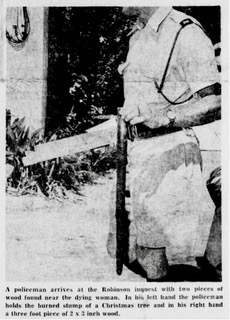
This conviction was held both by Chief Supt. J. A. Lodge of the Bermuda police and Det. Supt. William Baker, the Scotland Yard detective who [later] came to the Colony to investigate the murder in May of Mrs. Dorothy Pearce. Supt. Lodge testified at the inquest into Mrs. Robinson's death that there was a "strong possibility" Mrs. Robinson disturbed a prowler, despite the terrible nature of her injuries. She was found dying in a banana patch near her home on the morning of March 7, savagely beaten about the head and mauled around the body.
Supt. Lodge said that according to Supt. Baker, there was little or no evidence to tie the Robinson attack with other serious crimes in the Colony.
Supt. Lodge was closely questioned by the coroner about this. He admitted the attacks on Mrs. Robinson, together with two later attacks on Mrs. Pearce and Miss Kenny had one connection – they were all middle-aged or elderly women living alone and all had been beaten about the head. But there was a disparity when it came to motive.
The inquest was adjourned pending the results of the ongoing police investigations.
This was the second of two Warwick murders in quick succession – the first being that of Mrs. Gertrude Robinson and it immediately triggered a widespread and so far unsuccessful police search for the killer.
After this second murder, pressure to solve both crimes grew quickly and Scottish-born police commissioner R.G. Henderson took the unprecedented action of appealing to Scotland Yard to send Murder Squad men to help local police investigate the two outstanding murders.
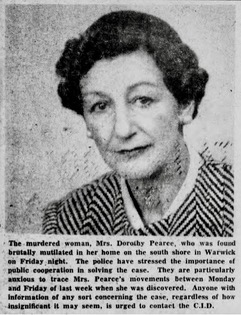
Lt. Cdr. Leo Pearce, the dead woman's former husband, was with the police who forced their way into the cottage. He was asked to identify the dead woman, but had difficulty in doing so. Her face was battered, bruised and bloody.
On Wednesday, May 13, 1959 Detective Superintendent William Baker and Detective Sergeant John O’Connell of Scotland Yard, arrived in Bermuda to assist in finding the “mad moon killer.”
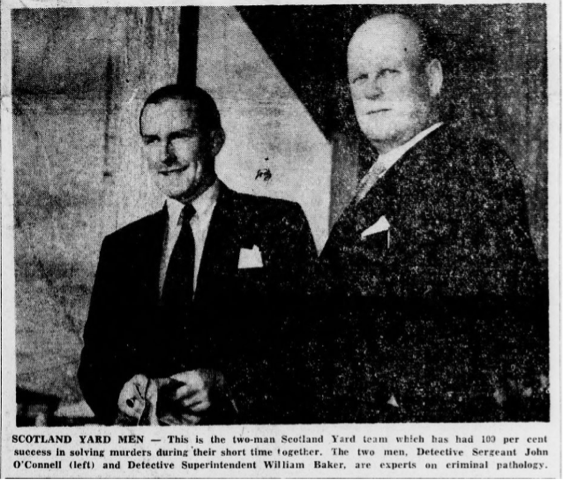
Supt. Baker said he and Sgt. O'Connell were requested to go to Bermuda at 9 p.m. on Saturday. Supt. Baker has been on the police force for over 30 years but Sgt. O'Connell is a younger man. He said that they would remain here in Bermuda until the case was solved or at least until every possible lead had been investigated. They have been working together for a short time at Scotland Yard and so far have cracked all the murder cases to which they have been assigned together.
The murderer of Mrs. Dorothy Pearce was probably heavily bloodstained after the murder and had badly damaged knuckles. That was what Detective Superintendent William Baker of Scotland Yard told a press conference yesterday evening. Supt. Baker, who arrived at 2 a.m. yesterday with Detective Sergeant John O'Connell, asked for public cooperation in solving the case. They particularly want information about the movements of Mrs. Pearce from Monday to Friday during the last week of her life, and about a bloodstained person with damaged knuckles.
Supt. Baker said last night that if people really made an effort, they could help out in the case considerably. He said it would be in their own interest to do so. It was a woman, he said, who always suffered in such cases. Since it could happen again it might be someone's wife, mother or daughter next time. There must be people, he declared, who had information which could be of the greatest assistance. Every effort would be made to treat information in confidence.
In discussing Mrs. Pearce's movements prior to her death from Monday of last week until Friday when she was discovered, it was suggested that it would be very strange if no one had seen her during that period doing some shopping or only taking the dog for a walk. Supt. Baker said that there was no reason to believe that previous attacks in the area had any connection whatsoever with the murder. This did not include the attack on Mrs. Robinson.
While rumours of every description circulated in the Colony during the following days ranging from stories of an arrest to stories of another sex incident last week, Scotland Yard’s two-man murder team quietly continued its methodical search for the answer to Bermuda's two recent unsolved killings. Almost every one of the numerous people interviewed gave some little bit of information which was helpful in the growing picture of what actually happened to the two murder victims. Det. Sergeant O’Connell compiled and correlated the information gathered from those persons interviewed during house-to-house enquiries in the Cobbs Hill area of Warwick.
The arrival here of two Scotland Yard detectives to investigate the foul murders that have shocked Bermudians has generally been welcomed. The Bermuda Police Force is not accustomed to dealing with dreadful, apparently motiveless crimes such as these. Experts are needed. It has been said that the Scotland Yard men have no knowledge of Bermuda or the conditions here. But when they are called to various parts of Britain by provincial police forces to unravel classes of crime not usually met with they have no knowledge of local conditions either. They are experts in a particular field and can obtain all the local knowledge they need from the policemen on the spot. The Scotland Yard men have appealed for the co-operation of the Bermuda public. They must receive that co-operation in the fullest measure. Not only is it the duty of every citizen to help the police to the utmost, in some circumstances it can be an offence to withhold that help. The maniacal murderer of two elderly, defenseless women deserves not a shred of sympathy. Even his closest relatives, if he has any here, should not hesitate to give information against him.
******************************
Meanwhile, in England a crowd of 500 rioted outside a gaol while 2,000 prisoners inside shouted oaths and obscenities in protest against the hanging of a man who murdered a policeman by stabbing. No one rioted on behalf of the dead policeman; nor were there any signs of collection boxes for his widow, if he had one. The "idealists" were concerned with the murderer, not the murdered. The man who represented the forces of law and order that protect citizens from being stabbed in the street or strangled in bed was forgotten by these demonstrating humanitarians. Their attitude is hard to understand. As for the shouting convicts, one hardly expects men in gaol to feel kindly towards the officers of the law who put them there. Hanging is a gruesome, even a barbaric business, it must be admitted. But when a young and ruthless killer is cornered by a policeman is he to be allowed to calculate the chances of his escape against a possible 15-year prison sentence?
Or is he to tell himself: "If I shoot and kill, I'll hang." Hanging is a powerful deterrent against murder.
****************************
Like a fine toothcomb, Det-Supt. William Baker spent almost two hours in a twin-engined naval seaplane circling the Warwick murder area studying paths or escape routes and the relation of houses to one another. The Scotland Yard man called in the Navy because he wanted to get an overall picture of the scene – an area he has, in his seven days here, come to know as well as London's Piccadilly Circus.
From the plane he hoped to see more clearly a possible pattern for the murder. During the flight several pictures were taken for the detective and his colleague, Det. Sgt. John O'Connell, to study in their office at C.I.D. headquarters. Dramatic radio appeals, were made again yesterday asking for help. Clergy even referred to the importance of police-public cooperation from their pulpits.
Mr. Baker said: "We feel that a close relation of the killer has not told the police all they know." He felt that the clothes of the killer must have been washed and bloodstained or missing articles noticed. If they were missing the relative might have attached no particular significance to the incident. "If they come forward now they might prevent another great tragedy," said Mr. Baker.
Meanwhile, Police were still pursuing their theory that a certain type of blood group can help to take them to the killer. More men will have blood tests at the King Edward VII Hospital in the next few days.
While headlines about Bermuda’s two savage sex murders are screaming around the world, and rumors are flying thick and fast in the colony as to who the sadist may or may not be, the two Scotland Yard detectives who are leading the investigation were quietly going about their business at the Police Headquarters, Prospect, this morning.
Det. Supt. William Baker, who like his London colleague Det. Sergeant John O'Connell, is now sporting a Bermuda tan said with a shrug “things are still routine.” Interviews and inquiries are being made and blood samples are still being taken where necessary.
Meanwhile, some of the more lurid details about the two unsolved crimes have made their appearance in the foreign press. One paper stated that some 40 suspects were being grilled in connection with the murders. There were indications that the murder probe had reached the stage where the large list of possible suspects was being slowly narrowed down, and it was hoped this would continue until the only name remaining would be that of the killer.
By May 26th an atmosphere of increased optimism seemed to pervade the offices of the C.I.D. where Scotland Yard's two famed detectives, were plotting the downfall of Bermuda's twofold sex killer. It also seemed not too unreasonable to hope that in the near future the killer's name and particulars would be revealed. Sifting through the evidence as if with a fine-tooth comb, investigations have now reached the stage where the large list of possible murder suspects is painstakingly being narrowed down until it is hoped that the murderer's name will be the one remaining.
After two weeks in Bermuda the two Yard men were still – “plodding along” and “treating each murder as a separate enquiry, until it is proved otherwise.”
The question of whether there was any probability that additional Scotland Yard officers would be brought into the case, Chief Superintendent Arthur Lodge said that there were nine detectives working on the case fulltime, and as many as 20 were out sometimes taking statements. He said there was certainly no reason to believe that any extra Scotland Yard men would be brought here.
On May 27th a large monetary reward was suggested in the House for information needed to track down “these two brutal murders.” The Yard men and local police chiefs were against the proposal however for a number of reasons which they listed.
On June 11th it was reported that the Yard men had made no plans to return to England. Supt. Baker said that rumours that an arrest has been made were untrue, as were the rumours that another murder has been committed and had been "hushed up" by the police. Supt. Baker said he was not pessimistic about the way investigations were proceeding.
On Saturday June 13th Chief Supt. J. A. Lodge, head of the Bermuda C.I.D., said:
"Inquiries are continuing in the prescribed manner; lots of statements are being taken; and we are continuing a nightly foot patrol in the Paget and Warwick area," "Everyone is working overtime on the cases; both the C.I.D. and uniform branch are putting in extra time during the hours of darkness," he said.
Chief Supt. Lodge paid tribute to the work done by the Reserve Constabulary, describing their efforts as "magnificent."
A recent rumour that a woman had been almost strangled in Devonshire was refuted by the officer. "I don't know where all these rumours originate," he said.
The two Scotland Yard detectives, Det. Superintendent William Baker and Det. Sgt. John O'Donnell, are still busy in their investigations and, according to the Mr. Lodge, "they will be here for some time." The victims of the two murders were Mrs. Gertrude Robinson of Cobb's Hill Road, and Mrs. Dorothy Pearce of "Bali Ha’i," off the South Shore Road.
Evidence at the inquest is expected from two Scotland Yard detectives, Superintendent William Baker and Sergeant John O'Connell, who were flown out here to investigate the two killings. Under normal circumstances an inquest into a death of this sort would follow legal proceedings – although the reverse procedure, similar to this one, was followed in the death of Mrs. Nellie Millicent Nolan. That inquest was followed by a murder trial.
It is freely rumored that the Pearce inquest will indicate that similar killings are not likely to occur again. The two murders have kept women in the Islands – especially in Warwick - in a state of fear.
As a result of the brutal murder, the second within a short period, the Bermuda Government brought two Scotland Yard detectives to the Colony to investigate. They are Det. Superintendent William Baker and Det. Sgt. John O'Connell. Superintendent Baker told the RG he did not know if he would be giving evidence at the inquest, "It depends on the coroner," he explained.
Asked about his plans to return to England he commented, "I will tell you that after the inquest is over." According to Superintendent James Lodge, chief of the C.I.D. in Bermuda, the inquest will last all day and possibly continue tomorrow. "There are many witnesses who will be giving evidence," he said.
……….. Whether or not the two Scotland Yard detectives will [yet] give evidence depends on the coroner.
……….. The [Pearce] inquest was continuing on Saturday afternoon with about nine more witnesses to be called.
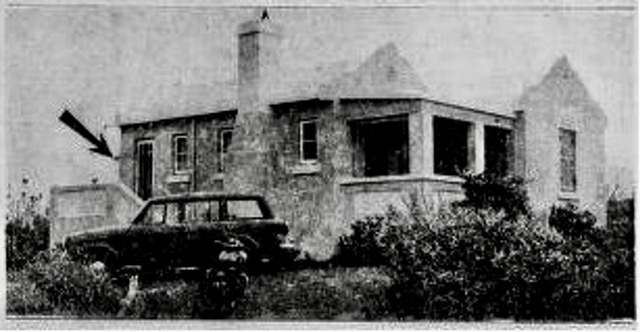 “Bali Ha’i” cottage where Mrs. Pearce was found murdered.
“Bali Ha’i” cottage where Mrs. Pearce was found murdered. At 10 o'clock on Saturday night the eight-man jury returned a verdict that Mrs. Dorothy Pearce was "murdered by a person or persons unknown."
In giving his evidence [before the coroner’s jury], Mr. Leo Francis Pearce, the deceased’s former husband said:
"I followed the police constable through the door between the kitchen and the living-room, which was in great disorder. One point I would like to bring out, Your Honour: I noticed there was a china book-end on the floor and that the corner was chipped off it, as if it had been thrown at somebody.
"I followed the constable as far as the doorway to the bedroom. The police constable said: 'Here she is.' He felt her arm or leg; it may have been her leg, I'm not sure.
I said: 'Is she dead?' He said 'Yes,' and I felt her outstretched arm, which was cold."
Mr. Pearce said he then called his attorney, the "lady doctor," and his wife, Mrs. Gladys Frame Pearce, asking the latter to come and collect the little Scotch terrier, Judy, which had been found locked in the cottage with the dead woman.
Another witness, the Overseer of the Mental Hospital, Arthur Adams, said that no patient had ever been out without his knowledge.
"They have escaped," he continued. "Early this year a patient was out but it was quite some months ago. I think it was before May 1. But as far as I can say from May 1 onwards no one has been at large."
In answer to a question from the jury, Mr. Adams said: "People do go out but they need permission from the superintendent and they must be accompanied by a relative or friend."
Mr. Patton then said: "I don't want you to name the person at all, but has anyone been out overnight since May 1?"
"No."
A juryman then asked if a roll-call was made at the Mental Hospital. Witness replied: "We don't make a head count but they have to be there for meals and at bed time."
Thirty-two witnesses had been called, the last being Detective Superintendent William Baker of Scotland Yard. Following his evidence in chief he gave a few theories which he had deduced from investigations he had been carrying out since he arrived from London on May 12, with Det. Sgt. John O'Connell.
The Superintendent said that to date there was no real evidence against any individual, although between 1,100 and 1,200 persons had been interviewed. The jury took 1½ hours to reach a verdict and [had] examined 35 exhibits during the long hearing.
The verdict was worded: –
a. That the said Dorothy Pearce, was found dead about 10.45 p.m. on May 8, 1959, at ‘Bal’i Hai’ in Paget.
b. That the said Dorothy Pearce died on or about Tuesday, May 5, or Wednesday, May 6.
c. That the cause of the said death was by strangulation after a struggle in which the victim received many blows which may have been administered by a brick in a sweater.
d. and we do further say that the said Dorothy Pearce was murdered by a person or persons unknown.
Both men had been staying at Grandview guest-house, Devonshire. They said they’d made "many good friends" during their stay here.
Superintendent Baker said they were leaving with "mixed feelings." He left the country wearing a straw hat he had purchased here, while Det. Sgt. O'Connell was carrying a large object wrapped in brown paper. This turned out to be a carriage whip, engraved with the names of all members of the Criminal Investigation Department in Bermuda. Sgt. O'Connell was presented with this gift when his promotion to the rank of detective inspector was unofficially announced about six weeks ago. Sgt. O'Connell will officially become Detective-Inspector O'Connell by the end of this week, Superintendent Baker said.
The two men were seen off at the airport by Chief Superintendent James Lodge, of the C.I.D, in Bermuda, Mrs. Lodge, Mr. John Elliott of the Secretariat, and Mrs. Elliott.
Mr. Lodge said: "We are very sorry to see them go. They have done a magnificent job."
The local police announced that they were continuing their probe into the killing. Of the other murder – that of Victim No. 1, Mrs. Gertude Robinson on March 7 – Chief Supt. J. A. Lodge said: "One or two essential witnesses are out of the Colony. When they return the matter of the reopening of the inquest will be put before the coroner."
The Scotland Yard men had returned to London, the police foot patrols in the Warwick area were gradually withdrawn and, once again, the Colony settled back to enjoy its anniversary year without thought of murder.
One week later however, on Sunday, July 26th 1959, all complacency was shattered by the screams of Miss Rosaleen Kenny who was beaten with a garden implement as she lay sleeping in her apartment on the Harbour Road only a few yards from Cobb's Hill Road. Miss Kenny was lucky after neighbors heard her cries for help and what might have been a third murder was averted by their timely intervention but not before her attacker had made good his escape. Miss Kenny was rushed to hospital where her condition was reported to be ‘’good and improving."
Piercing screams shattered the morning silence as she was battered from sleep with an 18" garden hoe by a vicious attacker in her neatly-kept apartment at "Kempdon" – a house a mere 100 yards away from the "murder mile" of Cobbs Hill Road. The beating took place at about 4.45 a.m. and the attacker got away in the cold grey half-light.
Miss Kenny (57) who had lived in the apartment for 10 years and who lately spent most of her evenings chatting with her friend, Lady Hood, estranged wife of the former Governor, Sir Alexander Hood, was rushed to the King Edward VII Memorial Hospital and treated for severe head injuries to her head and face. The screams shocked the owner of the house, 72-year-old Mrs. J. W. Kempe to consciousness. She started for Miss Kenny’s apartment. The noise awoke Lady Hood, currently holidaying in the Colony.
So vicious was the blow that the almost inch-thick hoe handle snapped where the wood met the metal. The metal part of the hoe was found near Miss Kenny’s pillow. But the wooden handle was found immediately under the veranda, which seemed to point to the assailant having attempted to fling it into the nearby harbour.
After the attack Miss Kenny was said to be calm. She even put a plastic bag on her pillow so that it would not get covered with blood that trickled from the wound in her head.
Miss Kenny, a long-time employee of the law firm of Conyers, Dill and Pearman was later said to be “resting satisfactorily.”
The acting Commissioner of Police, M. B. Parker, confirmed that the attack had taken place and that he had stepped up police patrols in the area.
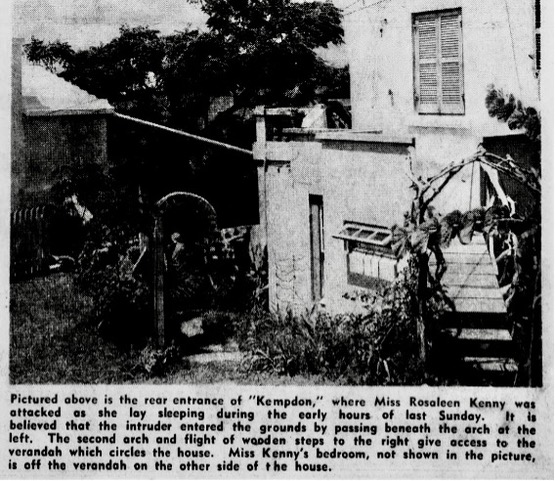
Miss Kenny was able to described her assailant as being not very tall, wearing shorts and either had no shirt or was clad in a dark-coloured shirt. He could have been a coloured man or a man with a deep sun-tan.
"We need some relief from this fear which is again gripping the inhabitants of Warwick and Paget." said Mr. E.T. Richards after criticizing the police for relaxing their night patrols in the area recently.
When the House assembled for the final time yesterday afternoon, with no business to enact, Mr. Vesey rose to remind members that there had recently been three serious crimes committed in a very narrow area in Warwick. The two murders (of Mrs. Robinson and Mrs. Pearce) had been investigated and no solution found.
Mr. Vesey went on, “I was rather surprised when the two detectives who came from England went home and one of the high police officials observed that they had done an outstanding job. They may have done outstanding work but they arrived at no conclusion.
“Following on that we now have another crime of a similar nature which could easily have been equally serious. "On this occasion what do we find? We find the Commissioner of Police (Mr. R. G. Henderson) is away on holiday. And the chief detective, whatever his name is (Chief Supt. J. A. Lodge) is away on holiday.
According to Mr. Vesey, "It was several days before the C.I.D. made any attempt to seriously investigate the matter. The man himself made a search of the grounds and found evidence which led to the detection of the person concerned.
"That is not good enough. The police have an important job to carry out and it is not good enough for the administration to be carried out that way. I understand one excuse offered was lack of transport."
Mr. Vesey hoped that during the summer recess "the responsible authorities will see to it that something is done about the administration of the police force."
Mr. Earle Outerbridge: Hear, hear.
Mr. Vesey went on, "If something is not done about it before the House reconvenes I propose to take some action in this House either by the appointment of a select committee or the appointment of a commission to investigate the administration of the police force."
Mr. Outerbridge criticized the police who, he claimed, could spot an illegally parked car half a mile away but seemed to have their eyes closed when it came to serious crimes. [Warwick member] Mr. E.T. Richards associated himself with the concern expressed by Mr. Vesey. “The people in Warwick have become very uneasy again after this last incident," he said. Mr. Richards noted that there had been five or six incidents in the same Warwick area of about half a mile radius.
"It seems to me that the department of investigation must see that pattern and must have some prime suspects. When this last incident took place, in view of the fact the police were alerted very shortly afterwards, they should have rushed to the homes of the suspects to see if they were there. That is what an amateur armchair detective like me would have done. But probably the method used by the police is orthodox, laid down."
Mr. Henry Vesey: “They like the little red book.”
Mr. Richards went on, "We need some relief from this fear which is again gripping the inhabitants of Warwick and Paget. Probably the best thing to do is to have vigilantes brought into being through the agency of the parish vestry. Mr. Richards felt the formation of such patrols would be an immediate deterrent to the criminal or would result in his being caught-red-handed.”
He said Mr. Harley Barnes, the Warwick parish clerk, was going to look into the matter to see what could be done. Mr. Richards told the House that after the murders in March and May people living in that area kept their front and back porch lights on all night. "They were turned off about a month ago but now they are back on," he said.
Mr. Richards felt the murderer was someone who knew the area very well, someone who had "cased" the area and knew where certain people lived.
“Like every hon. member I have my own theory and suspicion. The police have either to reorientate themselves or change their methods and not to relax their vigilance lest something else occurs."
Referring to the attack on Miss Kenny on Sunday morning, Mr. Richards said, "I think this woman was exceedingly lucky. It is purely by the grace of God that she got away.
"Nobody wants that sort of thing to be happening every two months."
Mr. Lodge told the Gazette that he had assumed responsibility of the case "under Mr. Parker."
“The old woman walked slowly along the Middle Road, paused for a moment under a street light at the junction of Cobb's Hill Road, and then turned up the hill.
She was visible for a few minutes until she slipped out of the circle of light and then, with a last, quick look behind her, disappeared into her home. Nothing unusual in this. Bermudians, especially the elder ones, walked long distances before the advent of motor cars and crimes of violence were then few and far between.
But this is 1959 and crimes of violence have featured [on] the front pages of the Colony's newspapers far too often in the last few months. And the stretch of road along which the old woman ventured unaccompanied has become known, and with cause, as "murder mile."
Now, residents of the area have resumed the stringent security measures which were relaxed prior to the latest attack. Woman folk are never left alone, porch lights shine down on locked doors, and the silence which pervades the area is broken only by the barking of dogs.
There are few pedestrians on Cobb's Hill Road after night fall – the old woman and a couple were the only ones seen in over two hours – and even the houses seemed deserted, despite the lights which came from all but two of them. A cruising police car slipped noiselessly through the main road junction, followed a few minutes later by the private car of a detective.
A brisk walk around the block took me along Morgan’s Road. Here the deep shadows between the street lights were even blacker and the rustling noise made by the trees sounded eerie. At the junction with the Harbour Road, directly opposite the scene of the latest attack, a dog, lying by the front door of a roadside house, poked its head into the light and gave a few well-meaning and convincing barks before returning to its resting place.
The detective's car came in sight again, slowed down when he saw me at the corner, then carried on. Between Morgan's Road and Cobb's Hill a restaurant was going about its business as patrons of the nearby Inverurie Hotel called in on their way home after the show. It was now early morning. Soon the taxi-drivers waiting in front of the hotel would go home, the last visitors would retire for the night, and "murder mile" would commence another period of suspense [until] the light of day afforded relief.”
At the end of the six-day mass fingerprinting operation however, a total of just under 700 Warwick and Paget West male residents between the ages 16 and 50 had volunteered their co-operation – a meagre figure compared to the original goal of 1,500. There were 2,000 eligible men living in the area.
MURDER VICTIM No. 4 – [RAWLINSON]
After receiving a missing person report during the evening of Sunday, September 27, 1959 police commenced digging up a private beach in their search for a woman’s body after they discovered items of bloodstained clothing buried in the sand. Police had found her bicycle at the entrance to the beach and went on to discover bloodstains behind a rock together with her bloodstained bathing suit, shorts and skirt soon after they began digging in the sand during the night by floodlight. Two days later, the floating body of attractive English girl, Miss Dorothy Barbara Rawlinson (29) was recovered from the sea by a fisherman on the private Southlands beach in Warwick Parish. Her shark-torn body had been found floating in tangled seaweed. It was not without suspicion that this death had been preceded by two murders and an attempted murder of lone females in the immediate vicinity.
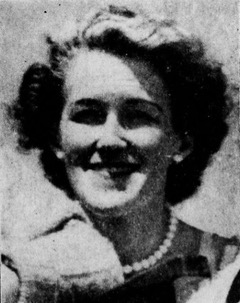
The RG reported later that squads of police had worked by floodlight to dig up Southlands Beach in Warwick. They were searching for the body of a 29-year-old Englishwoman, Dorothy Barbara Rawlinson, who went to the beach on Sunday afternoon. Miss Rawlinson was reported missing by the friends with whom she was staying, Mr. and Mrs. Thomas Sayers, of Fort House, Reid Street Extension. A routine police search of the beach yesterday swung into top gear when clothing was found buried in the sand near a rock. Police would not comment on a rumour that the clothing was bloodstained.
Extra police were rushed to the scene and dug all around the area. They gave up soon after nine o'clock. Two policemen stayed on the scene all night in a nearby bathing house and about 20 men were due to resume digging at 8 a.m. today. Miss Rawlinson had left Fort House for Southlands Beach at 2 p.m. on Sunday. She told the Sayers she would be home by six o’clock for supper.
Southlands Beach owned by Brig. H. Dunbar Maconochie, is less than a mile from "Bali Ha’i" the clifftop house where Englishwoman Mrs. Dorothy Pearce was found brutally murdered five months ago. Thorough police investigations of the crime, which included calling in two Scotland Yard Detectives, failed to bring a solution.
Two months before the Pearce crime, another Warwick woman, elderly widow Mrs. Gertrude Robinson, had been found dying in a banana patch near her Cobb's Hill Road cottage in Warwick.
This was followed on July 26 when another English resident of Warwick, Miss Rosaleen Kenny, was attacked in bed by an assailant wielding a garden hoe. Her screams frightened off the attacker, who escaped.
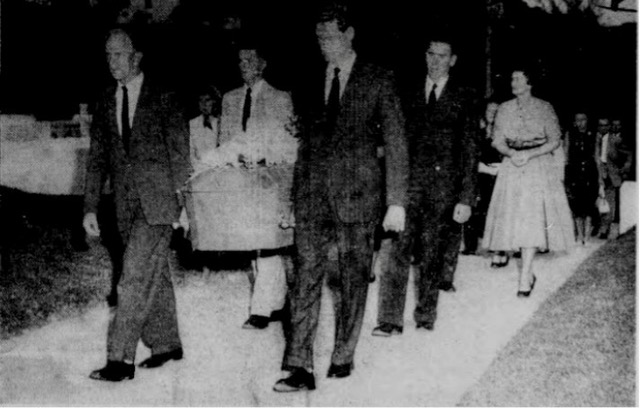 Four police officers were honorary pall bearers at
Four police officers were honorary pall bearers atThe shark-torn remains of a woman believed to be 29-year-old Miss Dorothy Barbara Rawlinson were recovered from Astwood's Cove yesterday morning. The discovery was made by a 69-year-old fisherman, Frederick Gunnison Astwood, about nine o'clock yesterday morning while police were digging up a beach half-a-mile away looking for her body.
The digging was being done at Southlands Beach, Warwick, where on Monday Miss Rawlinson's bloodstained clothes were found buried near a large rock at the foot of the cliffs. Blood was also spattered around the back of the rock and on bushes. The police removed the most badly-stained piece of rock and some bloodstained foliage.
On Monday afternoon he saw some sharks swimming around inside the reefs. "I know when I see sharks in the daytime something is wrong," he said yesterday. He "went overboard" looking for clues. "I saw something bobbing up and down in the whale grass. I got closer and saw it was a skull.”
Mr. Astwood pulled the remains up the sand of the quiet little cove and laid them carefully in the shade. He saw a policeman standing on a nearby cliff and shouted that he had found the body.
There was little left of the body which Mr. Astwood pulled from a large patch of whale grass floating in a quiet corner of Astwood's Cove. The arms were missing, the feet were off at the ankles and the body was a virtual skeleton
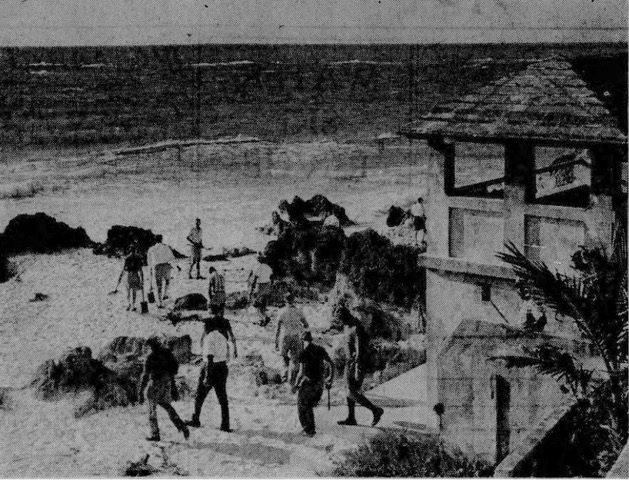
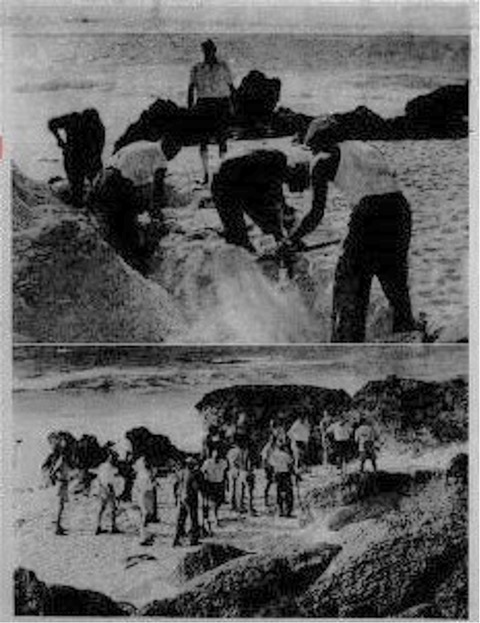 Police go to work at Southlands Beach digging around the rocks
Police go to work at Southlands Beach digging around the rocks Bermudians have been shocked and alarmed by the grim episode over the weekend resulting in the death of a young Englishwoman. Two women have been brutally murdered in the last seven months.
A third, viciously assaulted, was probably fortunate to have escaped with her life. Now the mutilated body of Miss Dorothy Barbara Rawlinson has been found and, from available evidence, the police think she may have been attacked while on Southlands Beach in Warwick West.
When is this trail of fear to end? Must the women of Bermuda again bolt and bar themselves in their homes when dusk comes? Must our reputation as a tourist haven again be damaged? We have no doubt the police are doing their best. The force is small but efficient and in normal circumstances can be considered adequate for a community the size of Bermuda. But the force does not have the scientific equipment nor the expert knowledge possessed by police forces in places abroad where serious crime is not such a rarity as it has hitherto been here.
It must be said, too, and forcibly, that the police regrettably do not receive the cooperation from the public that they are entitled to expect. It was only a few weeks ago that the police appealed to men of the Warwick and Paget West areas to attend for voluntary fingerprinting when the investigation into the attack upon Miss Rosaleen Kenny was under way. The response to the appeal was lamentable. It showed a dismaying lack of public confidence in the police force as well as a failure to appreciate the responsibility that rests upon every citizen to cooperate in upholding the law and the cause of justice.
Whether these dreadful occurrences are related is a matter of surmise. But doubtless the wildest rumours will again become a topic of daily conversation. We would urge the public to discount rumour. And one of the best ways of quashing rumour is for the police to keep the public, through the Press, as fully informed as they can so long as it does not hamper their investigations. If it is thought necessary for Scotland Yard detectives again to be called in, let the decision be made speedily so that they can get to work on the spot without delay.
These crimes must indeed arouse the public conscience. We appeal to the people of Bermuda who have information, however slight, which they think may bear upon these outrages, to go to the police immediately and tell what they know.
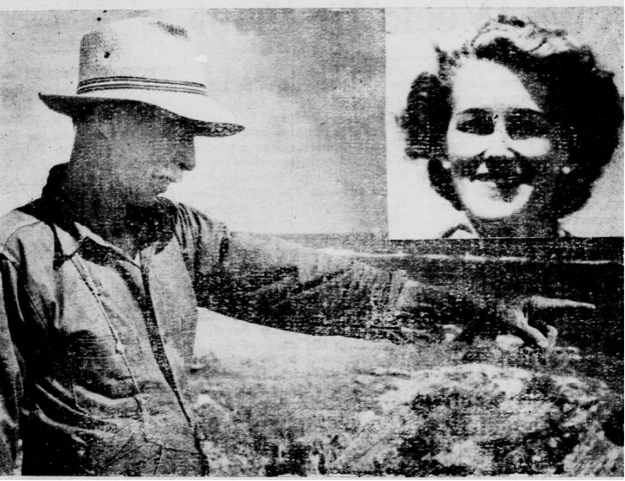
At a press conference yesterday noon Chief Superintendent J. A. Lodge of the C.I.D. said that if such a request were made it would be put through in 48 hours. In an earlier press conference, the Colonial Secretary, the Hon. J. W. Sykes, stated that investigations into the suspected murder were making good progress. Mr. Sykes' press conference was held in the Council Chamber, and was attended by correspondents of several British national newspapers as well as representatives of Bermuda newspapers.
At his press conference Mr. Sykes said that the Federal Bureau of Investigation would not be called in to help the Bermuda Police and no request had as yet been made for the help of Scotland Yard.
Mr. Sykes prefaced his remarks by emphasizing that the Government was fully aware of the great public anxiety "existing from three murders in the same locality'' as well as a serious assault. "The Government fully share the public concern and are determined to do everything possible to prevent such crimes occurring in the future.
Mr. Sykes recalled that after the murder of Mrs. Dorothy Pearce [in May], two Scotland Yard detectives had visited the Colony and spent six weeks investigating. Although their visit might have been disappointing to the public since there was no arrest, from the police point of view it was an invaluable visit. They were able to assist and train the local police and demonstrate techniques of criminal investigation. They laid down a system which is now being used by the police in their investigation of the latest crime.
"l have inquired and learned, through the U.S. Consul General here, that the F.B.I, are not now employed outside the United States.
“If the Bermuda police say they want Scotland Yard, we will call on Scotland Yard, who have expressed readiness to help.”
…
Britain's top crime fighting machine, Scotland Yard, has been called in to probe Warwick's latest suspected murder — that of Miss Barbara Dorothy Rawlinson — it was revealed by the Police at a press conference at noon on Saturday. Two murder squad men are expected to arrive in the Colony within 48 hours following a 3,400-mile flight.
Chief Supt. J. A. Lodge, head of the Bermuda C.I.D., was unable to say whether Supt. William Baker and Inspector John O'Connell will be the men, although the "murder mile" of Cobbs Hill Road is just as well known to them as their Soho beat after six weeks of intensive probing in connection with the murder of Mrs. Dorothy Pearce.
Asked why the Yard help had now been requested, Police Commissioner R. G. Henderson said: "We do not want any stone left unturned in this latest case." Police authorities on Friday contacted the Colonial Secretary who flashed a cable to the Colonial Office in London who, in turn, contacted the Yard officially. The murder team — a superintendent and a detective sergeant — should be packing their bags now.
Chief Supt. Lodge said: "We have more leads in this case than in any of the others. The yard men will be on the job as soon as they set foot in Bermuda and all the information we have gathered from a very helpful public will be at their disposal. "All the laboratory facilities in London are at our disposal."
Of the case so far, the C.I.D. chief Said: "Lots of persons are volunteering valuable information."
The Scotland Yard men will have their headquarters in the old Health Department building at the junction of Reid and Parliament streets.
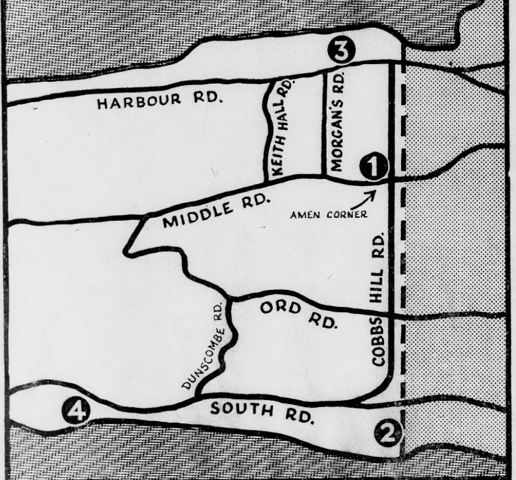
The men, whom Chief Superintendent J. A. Lodge, head of the Bermuda C.I.D. described as very “experienced”, started sifting and counter-checking clues with an hour of their arrival. They will review the records on this Rawlinson case, together with the files on the previous unsolved murders of two elderly Englishwomen on the island earlier this year, and the near-fatal attack on an Irish woman, last July.
It will be recalled that two Scotland Yard men had been sent to Bermuda last May to investigate the murder of the two elderly women, but to no avail.
“They face a bleak task. Perhaps the most disheartening fact is that they might as well be working without the body ever having been found. It was little more than a skeleton when found in the shallows and post-mortem examinations have been useful only in showing that Miss Rawlinson had not been battered to death, for no bones were broken.”
“Now there is great optimism at the police H.Q. There is a feeling that the Yard men will be presented with an important file of information which will help them to find a swift solution to the third murder of a woman this year. But among the nervous folk of Bermuda there will be no peace until there is an arrest.”
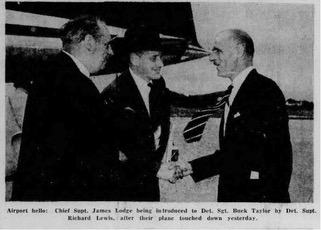
Dear Mr. Editor,
This letter of necessity will be brief but I am so mad reading your paper this morning that I can hardly think straight anyway. You know, of course, that I refer to this murder investigation.
Of all the pious, imbecilic attitudes to take "the decision to call in Scotland Yard or not must be taken up at Government level." If I didn't consider myself a lady I could think of a nice short answer to that one. The whole truth of the matter is there is too much "buck passing," nobody wants to take the responsibility of upsetting the powers that be or the liberties of the individual.
Well, let me tell you that those of us who have a clear conscience, and there are many of them, are not at all perturbed by the compulsory fingerprinting idea. As for the information that Scotland Yard can be called within 48 hours, don't give me any of that. Get on the long-distance phone and get them on the next plane out.
Another thing while we are on the subject, what's wrong with getting extra help from all retired policemen. The old-timers who were on the force for years and knew their districts and people like the back of their hands.
Well I have said what I wanted to say and I hope that somebody's got guts enough to act. Whoever it may be, he can rest assured that the Bermuda public will back him to the last lonely, terrified woman. Yours sincerely,
K. M. HENDERSON
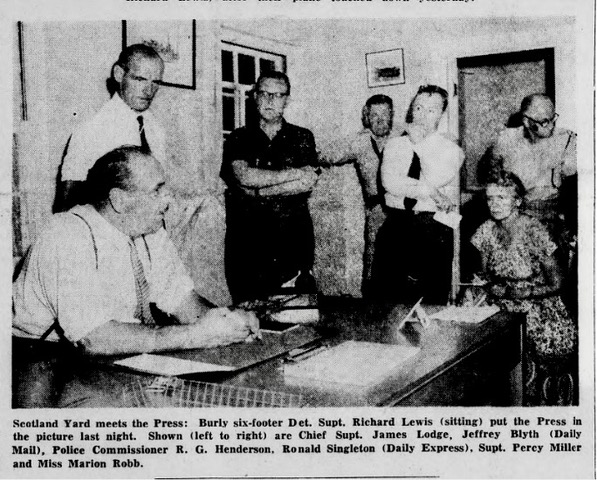
Scotland Yard veteran Det. Supt. Richard Lewis had been in Bermuda for just four hours when he told newsmen last night that he will probe not just the Dorothy Rawlinson case but the whole seven months of violence. The 50-year-old detective, with 30 years of experience in the Yard, told reporters at a special press conference: "We’re not interested in fancy theories or bright ideas – just facts. "We will start right from the beginning and will not let anyone influence our minds. We will take in the whole picture."
Asked if he ever had to probe a killing where there was little left of the body, the detective said he had not, but that is "not a serious stumbling block."
Was the death of Dorothy Rawlinson on a quiet beach just over a week ago a difficult case? "I do not look on it as any more difficult than any other inquiry. It must be done thoroughly," replied the burly six-foot Yard man. The seven months the detectives will put under the microscope includes three murders, one known vicious beating and some assault cases.
Mr. Lewis is known to have worked on the case of Anne Noblett, the young girl who was murdered in Hertfordshire, England. She was missing for a month and was eventually found in a refrigerator. Two men were found but not enough evidence was forthcoming to convict them.
The detective was also on one of the fastest of the Yard's probes. That of a Salvation Army girl murdered in North Wales. The detective left London at six o'clock. Two miners were arrested at eleven.
With Mr. Lewis is 43-year-old "Buck" Taylor. The sergeant – whose job is to record the thousands of facts gleaned in inquiries in a huge "murder ledger" - joined the "murder squad" two years ago. Before that he worked on many cases with Mr. Lewis when the Supt. was in charge of a division in the west of London.
Only occasionally did they look out at tourist landmarks.
1.30 p.m. The landing with customs formalities and greetings.
2.15 p.m. Guest-house arrival for a freshening-up.
2.45 p.m. Into a police car and the drive to C.I.D. headquarters at Prospect for a conference with police chiefs.
3.45 p.m. They left with Chief Supt. Lodge for an official visit to the Colonial Secretary who had cabled for their assistance.
5.30 p.m. Their press conference and later back to sifting information gleaned by the local police.
The time: 2 a.m. and they had "music" while they worked. The 4,000-mile flight from London the previous day had shattered their normal sleeping habits. The men turned in exhausted after a hectic first afternoon, at 10 p.m. But the four-hour change in time had them wide awake again at 2 a.m. – in London the time was 6 a.m. Instead of the rasping of London starlings, six-footer Det. Supt. Richard Lewis pored through murder dossiers to the chirping of tree-frogs in the oleander hedges round their guest-house. Commented the tough Yardman, on his first job out of Britain: "They were really quite musical. I liked them very much."
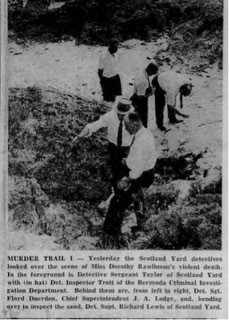
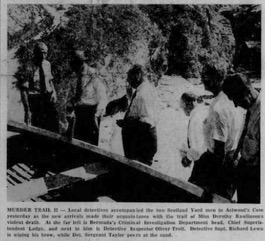
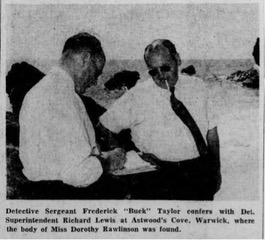
As they reviewed the case histories of the previous attacks the Yardmen were conspicuous in their starched white-collared shirts and ties as they roamed the white-sand private beach for two hours while calypso-shirted tourists ambled by on the South Shore Road immediately above them. And the conclusion they came to yesterday at a 1 p.m. press conference was: "There was obviously violence, a suspected murder."
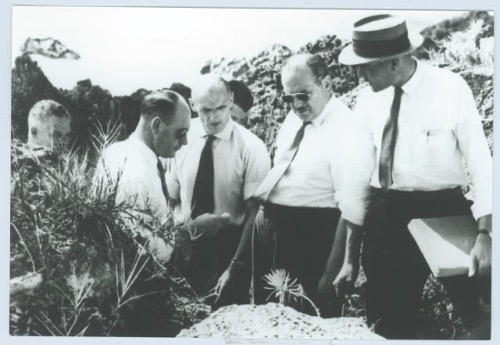 (l-r) Det. Floyd "Happy" Duerden; Det. Sgt. Frederick James ‘Buck’ Taylor;
(l-r) Det. Floyd "Happy" Duerden; Det. Sgt. Frederick James ‘Buck’ Taylor;
On the question of rewards for information leading to the arrest of the killer, Mr. Lewis said he would rule out rewards "because rewards are dangerous." Det. Supt. Baker, when he was probing the Pearce murder, was also against rewards on the grounds that they might produce tainted evidence.
As investigations proceeded in the days ahead ………….
...
Gaps in the jigsaw puzzle were filled in during Wednesday's investigation but there was no specific information. There are one or two "particular suspects," and meantime a process of elimination is taking place. "That is why it is vital to know anyone who was near that particular area," explained Superintendent Lewis.
…
Supt. Lewis and his assistant, Det. Sgt. Buck Taylor, continued their work until 3 a.m. yesterday, then put in another full day.
In the hectic six days since their arrival from London to take charge of the probe into the slaying a fortnight ago of Miss Barbara Rawlinson the two-man Scotland Yard team has taken about 100 statements.
As a result of checking and re-checking of statements it is believed that a time vital to the inquiry has been indicated to [the detectives.]
…
This morning skindivers were searching the South Shore coast line in the hope of being able to recover the fancy, home-made beach robe Miss Rawlinson carried with her to Southlands Beach the day she disappeared. The wrap consisted of two beach towels joined together. Their basic colour was white, and they contained coloured labels of holiday resort designs, including one of Bermuda and another of Paris. When worn the wrap fell to knee-length
Bermuda's policemen were being asked last night "How about a swim in the morning?" And today, at low tide (9 a.m.) about 25 volunteers are expected to don snorkels and diving masks and slip into the sparkling waters off the South Shore in Warwick. A pleasant task – but one with a grim purpose. The police, spearheaded by two Scotland Yard murder squad detectives, are issuing a widespread appeal for a gay bathing wrap, the only article of clothing which has not so far been recovered in the Barbara Rawlinson suspected murder case.
A popular theory is that whoever attacked the quiet-living, 29-year-old English girl as she lay reading on Southlands Beach on September 27, dumped her body into the ocean wrapped in the beach robe.
It is stressed by the police that even a torn piece of the wrap might provide a valuable clue.
…
Last night, while parents of Warwick Academy pupils flocked to a meeting at the school, policemen quietly prepared in a nearby classroom for another night of patrol of the "Murder Mile" area. Five extra cars have been taken over as patrol cars for Warwick, thus relieving the overworked regular police vehicles in the stepped-up protection plan for the parish.
The Editor,
Sir:
…………… Since my identity is unknown to the general public, I have lately been amused (?) to hear myself, and other writers of letters to the press, described as "hysterical agitators," by unintelligent people in the Colony.
"Hysterical," I can assure them, we are not! "Agitators" we certainly are – for some effective action on the part of the local authorities which will control crime in these islands. May I take this means to remind Scotland Yard’s Mr. Lewis (who has stated to the press that he had no faith in "tracker" dogs) that it was not Scotland Yard who tracked down the murderer of a London policeman who has since been tried and convicted. It was a "tracker" Alsatian dog who "got his man."
Now let's see if Mr. Lewis can do the same!
The two Scotland Yard detectives now investigating Bermuda's recent epidemic of crime, and particularly the death of Miss Barabara Dorothy Rawlinson a fortnight ago, bring to their job a wealth of experience. They are experts in their line, but detective work in ordinary life bears no resemblance to the detectives glamorized in film and fiction. It is a painstaking, tedious task of checking and crosschecking, of sifting and sorting, of questioning and eliminating.
To protect the innocent as well as to find the guilty is the purpose of the Scotland Yard men. For this they need the help and co-operation of every citizen in Bermuda. Anyone who was in the vicinity of Southlands Beach or passing along the South Road between 2 p.m. and 7 p.m. on Sunday, September 27, is under a duty to inform the police whether they have anything significant to impart or not.
The recent crime wave, unprecedented in the Colony's history, has shocked and alarmed Bermudians. But the criminal or criminals will never be detected unless the police get the help from the public that they are entitled to expect.
The men from Scotland Yard and the men of the Bermuda C.I.D. are working together in the interests of the Colony. There should be no reluctance on the part of any Bermudian to come forward if they have information, however trivial, which they think might help in the investigation. The Scotland Yard detectives seek no kudos for themselves. They are seeking to help Bermuda. And Bermudians should do their utmost to help them.
A 14-inch bone, believed to be a humerus or upper arm bone, was found by Mr. Park Breck during the underwater search off Southlands Beach yesterday morning, near the spot where the remains of Miss Dorothy Barbara Rawlinson were found two weeks ago. Mr. Breck, an underwater swimming instructor, said: "It had a few marks on it, which could have come from sharks' teeth. It was yellow in colour and seemed new."
ON THE BEAT AND ON THE BEACH
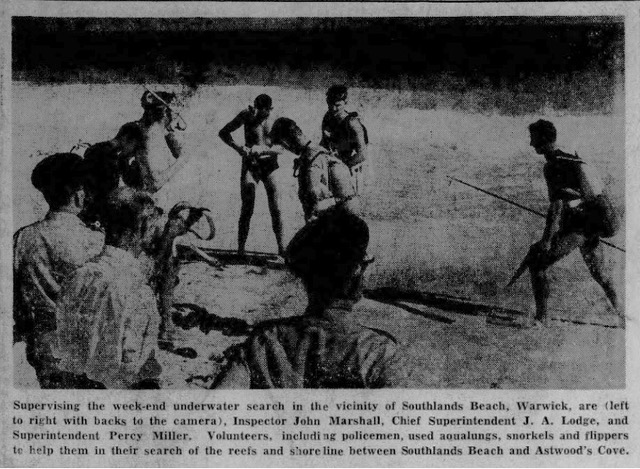
"It was a difficult area to search" Mr. Breck commented yesterday. "There were a large number of tunnels and holes in the reefs and they were under-cut as much as 35 feet. I've not seen anything like it before."
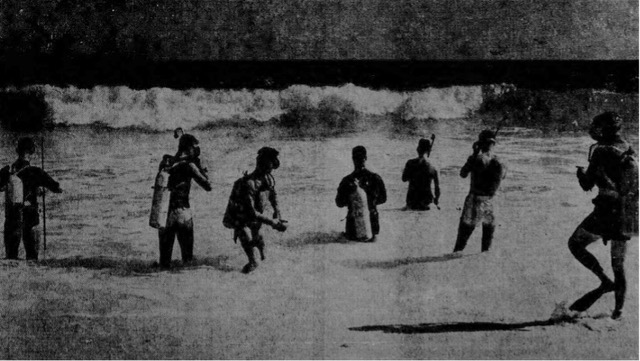
The search was done by swimmers working as far as 150 feet out from the shore. Holes in reefs were thoroughly probed, Mr. Breck remarked, adding: "If something were deep in there it would remain for the rest of its natural life." A bathing cap was found deep in one of these tunnels.
The other discovery of the day was a woman's rubber headband, used for keeping hair out of the wearer's eyes. "The headband looked as if it had been down for some time" Mr. Breck said. He thought it quite possible that the bathing wrap, if it had been underwater, would have been ripped to pieces by the surge of the sea. The underwater search was organized by Chief Superintendent J. A. Lodge, of the local C.I.D.
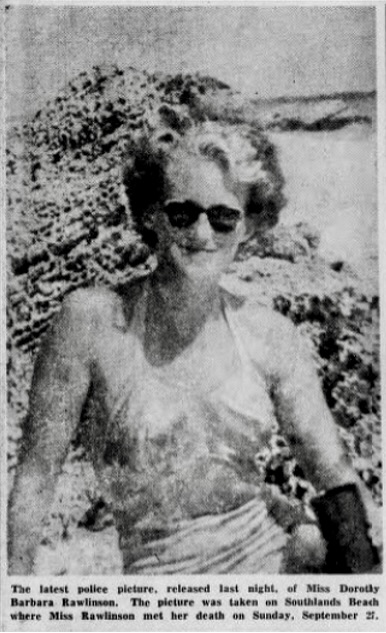
Anyone coming forward with information regarding the death of Miss Barbara Rawlinson on September 27 need fear no publicity nor breach of confidence, Det. Supt. Richard Lewis told The Royal Gazette yesterday.
"Everything told to us will be treated in confidence," he added. Newspapers had played an important part in publishing appeals for information, the Superintendent commented. Many visitors to the Islands, travelling on the South Shore Road in the vicinity of Southlands Beach, Warwick, had come forward after reading local newspapers, and were still cooperating.
Regarding the investigation, Mr. Lewis was of the opinion that it was safe to assume that Miss Rawlinson had gone to the beach alone on the afternoon of September 27, expecting to meet some of her friends who also had permission to use the beach. Remarking that in his work as a police investigator he was never optimistic or despondent, the Yard man did admit that in the week he and Det. Sgt. Buck Taylor have been in Bermuda "we have done an awful lot."
The following: police appeal for information, in connection with the investigation into the death of Miss Barbara Rawlinson on September 27, was given yesterday by Detective Superintendent Richard Lewis of Scotland Yard:
The Police desire to trace a man who walked through the grounds to Southlands in a westerly direction; that is, upwards through the estate, from the entrance to Southlands Beach, between 5.30 and 6 p.m. on Sunday, September 27.
Description, briefly: 28-35 years of age, between 5ft. 5in. and 5ft. 8in. in height, slight build, dark hair (longish and well combed), colour of skin – similar to Portuguese type. He was dressed in a white sweatshirt (could have been undershirt) and khaki trousers.
This man may be in a position to supply important information, and he is asked to communicate with the Police as soon as possible.
The police are also anxious to trace a person who lost a pair of white man's underpants (boxer type) in the vicinity of Southlands Beach on the evening of Sunday,
Detective Supt. Richard Lewis Scotland Yard murder investigator who is in charge of the Rawlinson murder case was unable to hold his daily press conference at noon today for the first time since arriving from London on October 12 with his colleague Detective Sgt. “Buck” Taylor. The reason according to a spokesman in his office was: “He’s too busy.”
The spokesman said he was authorized to say that there were no fresh developments in the case.
Police investigators are still trying to pin down the approximate time that Miss Dorothy Barbara Rawlinson is presumed to have been attacked on September 27. The time schedule of that Sunday afternoon is causing the two Scotland Yard detectives their biggest headache, it was learned yesterday. The police have not yet located the man who was seen walking through the "Southlands" estate from the entrance to the beach between 5.30 and 6 p.m.
At a press conference at noon on Saturday Det. Supt. Richard Lewis, of Scotland Yard, who is here to investigate the murder of Miss Dorothy Rawlinson and two other brutal murders, said that neither of the men had come forward to the police. In answer to a reporter's question, he said the police were confident they could identify by modern scientific means, the body found floating at Astwood's Cove as that of Miss Rawlinson.
It seems that most men called Taylor are given the name of "Buck," for some reason or other. Sergeant Buck Taylor of Scotland Yard, however, has a legitimate reason. He was born and bred in Buckinghamshire, and his real names are Frederick James.
Together with Superintendent Richard Lewis, Sgt. Taylor is here to investigate the death of Miss Barbara Rawlins, and this is the third murder case he has been on this year. The first concerned the stabbing of Police Constable Summers in London, which concluded in January, and the second was the murder of a nurse in Wolverhampton a few months ago.
Mr. Taylor joined the police as an "ordinary copper" nearly 24 years ago, serving in the London area. During the Second World War he did flying duties with Coastal Command as a navigator. In 1947 he joined the Criminal Investigation Department as a Detective Constable, based at London Bridge, where he remained until 1953.
By this time he was a Second Class Detective Sergeant, and was sent to Chelsea. That was when he first met Superintendent Lewis. In the middle of 1957 Mr. Taylor was transferred to the Central Office, New Scotland Yard, and was promoted to First Class Detective Sergeant. Since then he has been with the Murder Squad, which handles all major investigations, including murders. This is the third major investigation Sgt. Taylor has worked on with Superintendent Lewis, although he has investigated others with different superintendents.
He told me that such an investigation involves a lot of routine work. In police parlance, he said, this meant "99 per cent perspiration and one per cent inspiration." This is not Mr. Taylor's first murder investigation outside the United Kingdom. About three years ago he had to follow a murderer of a Pimlico prostitute to France.
Both he and Superintendent Lewis are married, and both have long service awards for good service and exemplary conduct. These medals are only awarded to those who have over 22 years' service in the police force.
An urgent appeal has been made requesting persons who were on certain beaches on the day Miss Dorothy Rawlinson was killed to report to the police:
"The police are anxious to trace any person who was bathing at a beach on the South Shore known by one of the following names — Faraway, Petty's, Simmons, A.B.C., or Atlantic Beach — between 3 and 4 p.m. on Sunday, September 27, 1959, who has not yet made a statement to the police.
"The police would also like to trace anyone who saw a male person bathing at the location at the time and date in question.
"This information is urgently required to corroborate information already in the possession of the police." Supt. Richard Lewis of Scotland Yard, repeated that everything of an assault nature which has occurred recently here has been taken into consideration in the investigations.
Awaiting Reports from Forensic Laboratory
Detective Superintendent Richard Lewis, of Scotland Yard, said that he is now waiting for reports about the exhibits sent two weeks ago to the forensic science laboratory in New Scotland Yard. Meantime, he added, the C.I.D. have spent two days checking times of people who were in the vicinity ………………
The police are also still interested in information from anyone who was on the Warwick beach known variously as Simmons, Petty’s, Faraway and the Atlantic Beach Club between 3 and 4p.m. on Sunday, September 27.
Wendell Willis Lightbourne Alleged to Have Told Police “She wasn't dead when I left”
The baffling Murder Mile Mystery reached a dramatic climax this morning when Wendell Willis Lightbourne, a strapping big 19-year-old youth of Spring Hill, Warwick was formally charged before the Wor. P. R. Grey in Hamilton Magistrate's Court with the murder of Miss Dorothy Rawlinson at Southlands Beach, Warwick on September 27, and also with attempted murder of Mrs. Florence [Lilian] Flood on Cobb's Hill, Warwick on July 19, last year.
Chief Superintendent J. A. Lodge told the court that he and Det. Supt. Richard Lewis, the Scotland Yard expert saw Lightbourne in Hamilton Police Station at 10.30 this morning. When they read the Rawlinson charge over to him, and cautioned him, he is alleged to have replied: “When I left she wasn't dead.”
In respect to the Flood charge he replied “I know nothing about it,” Mr. Lodge stated.
The magistrate remanded the youth in custody for 14 days. He will be defended by Miss Lois Browne, barrister-at-law who was in court. The Attorney General, the Hon. J.C. Hooton represented the Crown in the case.
The Attorney General was asked by Mr. Grey if he could indicate when he would proceed with the hearing. Mr. Hooton replied “I am sure you will realize this is a complicated matter and I am not willing in view of the great public interest in the case to attempt to commit myself any more than to say that a matter of this sort will proceed as soon as possible.
Lightbourne, a strongly built lad who appeared to weigh about 180 lbs., was escorted into the court room by two constables. He was dressed in black trousers and a black zippered lumberjacket with upstanding collar and wide-open neck. He walked heavily, had fixed eyes, and sported long sideboxes on his smooth skinned face. He stood throughout his appearance in court.
Excitement in the case has been at fever pitch since yesterday afternoon when Mr. Lewis issued a terse announcement that an arrest had been made and that the charges would follow in court today.
The news climaxed a reign of terror and murder in the Warwick area which resulted in two teams having to come to Bermuda from the famed Scotland Yard murder squad in London.
Supt. Lewis and Det. Inspector William Taylor flew here 26 days ago following Miss Rawlinson’s death. They took charge of the investigation.
Miss Rawlinson, a Londoner, came to Bermuda in May. She liked the colony so much she decided to get a job with Hand Arnold Ltd., and stay. She was fond of swimming and on the afternoon of Sunday, September 27, she went to Southlands Beach, but never returned home.
The following day her bloodstained clothes were found buried in sand on the beach, and a day later her body was recovered from the waters near the beach by a fisherman. It was a mere skeleton, and believed to have been attacked by sharks seen in the area.
Traffic was snarled up outside Hamilton Police Station since shortly after 9 o’clock this morning. Crowds gathered on the sidewalk to watch as police and court officials hurried back and forth. A few lucky ones managed to get into the court and listen to the proceedings.
A battery of press photographers waited in the corridors hoping to snatch a picture of the accused, but they were driven away by police.
This morning in Hamilton magistrates court a man who was detained by the police yesterday morning will be charged with the murder of Miss Dorothy Barbara Rawlinson at Southlands Beach on September 27, and with the attempted murder of a woman in 1958, according to an announcement yesterday by Det. Superintendent Richard Lewis, the Scotland Yard man who came here to head the investigation at the request of the Bermuda Government.
Superintendent Lewis and other police officials concerned with the case refused to go beyond the superintendent's brief formal statement, but it is believed the man who will be charged is coloured, big-built and young.
Last night there were no details available from police sources other than Supt. Lewis' announcement, made in the afternoon about 4 p.m.:
"A man is to be charged in Hamilton magistrates court tomorrow (Saturday) with the murder of Miss Barbara Dorothy Rawlinson, aged 29, at Southlands Beach, Warwick, on Sunday, September 27.
"A man who was detained this morning will be charged later today (Friday) with the murder of Miss Rawlinson at Southlands Beach and with the attempted murder of a woman in 1958.
The name of the man will be disclosed after he has been charged.”
Wearing a high-necked zip-up windcheater, uncreased black trousers and black moccasin shoes, Lightbourne is brown-skinned with short crinkly hair and about 5 feet 8.
He remained impassive throughout the hearing, occasionally stroking his sideburns and moustache. He followed the conversations between the magistrate, the Wor. P. R. Grey with interest. Only once did he look up at the 40 people crowded into the courtroom.
The green - painted upstairs courtroom began to fill with people from 10.30 onwards. More than 30 members of the public, including 10 women, were allowed to sit and stand at the eastern end of the court. There were also eight journalists present.
At two minutes to 11 the Attorney General the Hon. J. C. Hooton entered the court, wearing a grey suit, light grey tie and blue I shirt. He was followed by Chief Supt. James A. Lodge, head of the Bermuda C.I.D., and Det. Supt. Richard Lewis of Scotland Yard, who arrested Lightbourne on Friday morning. They were in turn followed by Miss Lois Browne, who will defend Lightbourne. Supt. Lodge wore a brown suit and bow tie, while Supt. Lewis wore a light-coloured suit.
Promptly at 11 o'clock the court rose as Mr. Grey arrived by the western door. After some bustling sounds outside, Lightbourne came into court by the same door, between two policemen. He was pulling down his windbreaker, which he appeared to have been wearing over his head on his journey up from the cells. Lightbourne stood in the dock, hands on hips, flanked by the police officers. He said nothing.
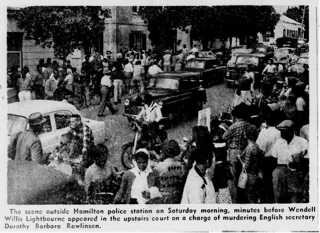
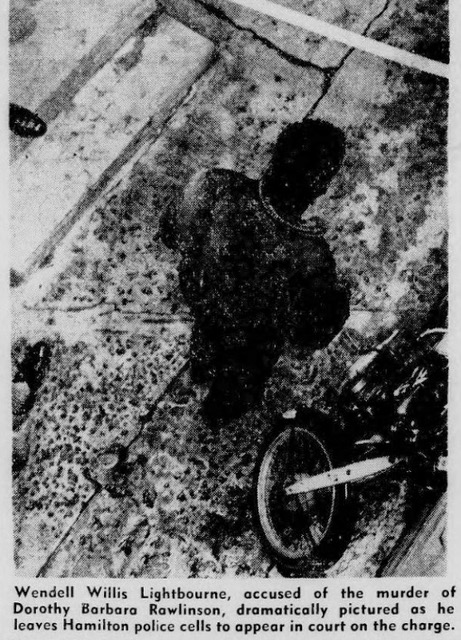
Mr. Grey then read out the two charges:
The only witness called was Supt. Lodge. After taking the oath Supt. Lodge told the court:
"At 10.30 a.m. this morning, your worship, in company with Det. Supt. Lewis I saw the accused at Hamilton police station.
"I told him we were police officers and read each of the charges over to him.”
“In respect of the Rawlinson charge, after he had been cautioned, he said – “When I left she wasn't dead."
Mr. Hooton then tendered the alleged statement as evidence.
Supt. Lodge went on: "In answer to the Flood allegation, the accused replied: “I know nothing about it." Miss Browne had no questions to ask.
Lightbourne was remanded in custody for a fortnight.
The acting Governor, the Hon. J. W. Sykes, when reading the Throne Speech at the opening of Colonial Parliament yesterday afternoon in the Public Buildings, said [in part]:
“Continuing prosperity in Bermuda this anniversary year has been marred by "events which have at times placed a severe strain on the limited resources of our Police Force," he said.
He noted that by the end of October………. the Treasury balance at the end of October was £729,277. In a presumed reference to the dock strikes and series of murders this year, Mr. Sykes said he greatly appreciated the devotion to duty shown by the police.
He told the assembled members of the Legislative Council, the House of Assembly and heads of Government departments, “We also owe a deep debt of gratitude to the Commissioner of the Metropolitan Police Force in London for the willing and valuable assistance which he so promptly provided in response to our appeals for help. You will shortly be asked to consider measures for enabling our local Police to continue on a more permanent basis to obtain the benefit of the skilled assistance which Scotland Yard provides, and I trust that when these proposals are put before you, you will give them your sympathetic consideration.”
A six per cent increase in crime over the preceding year is mentioned in the 1958 annual report of the Bermuda Police Force, received by the House of Assembly.
In his annual report, Mr. R. G. Henderson, the Commissioner of Police commented: "Considering that full employment and sound economics prevailed this is indeed serious." He added, "Without attempting to be complacent”, the Commissioner wrote, “I must say, however, that crime statistics of the U.S.A., Canada and the United Kingdome for 1958 all show a greater increase of crime than 6%.
The acting Governor went on to say that unfortunately this 350th Anniversary of the Colony's foundationhas been marred by events which have at times placed a severe strain on the limited resources of our Police Force. It would be wrong of me here and now to refer to these matters, but I hope it will not be inappropriate if I say that we have greatly appreciated all the hard work and the devotion to duty shown by all ranks of the Force.
As the Colony's "general business manager" in his substantive post of Colonial Secretary, the acting Governor is probably much more aware than the general public of the severity of the strain upon the Police Force to which he alluded. We shall be interested to see what methods are proposed for permanently enlisting the aid of Scotland Yard. At first blush, it would seem that such a consummation would be effectively possible only by recruitment of skilled personnel. But that is only a guess. We all know from experience that there are certain changes that might well be made in our law, especially that part of it relating to finger-printing and the powers of the police therein. We have had time to reflect upon this aspect of the situation, so that we need not be accused of haste or panic in sensibly effecting whatever changes have been demonstrated to be desirable. And we hope that thought will be given to the use of police dogs. These are two areas in which legislative support could furnish the Police Force with some of the additional aids it has so obviously needed.
It has been plain for some time that onerous tasks have been laid upon the Police Force with the advent of motorization. And he is a brave man who will say that the effects are felt only in the enforcement of our traffic laws. At the least, motorization has given the criminal advantages he never possessed, as well as adding considerably to a general restiveness in the Colony. Yet in the broad reaches of crime we do not, according to the latest report of the Commissioner of Police, seem to be doing too badly. He notes that the six per cent increase in crime last year was a lesser one than was recorded in the United States and England. And some emphasis is laid upon the fact that there is here, on the part of the public, considerable carelessness in the disposition of valuable property, with its considerable bearing upon "our most serious and ever-increasing incidence of crime – house, shop and store breaking.” That was in 1958, of course, but the report comes at a time to give perspective and facilitate reflection upon 1959.
During early November, the first of two consecutive preliminary inquiries (PI’s) into one of Bermuda's major mysteries – the death of quiet living London office worker Miss Dorothy Barbara Rawlinson – was held behind closed doors.
Outside the courtroom, Parliament Street was normal as Lightbourne, in a neat brown tweed sports jacket, white shirt and a knit-wool tie, climbed the 22 stairs to the courtroom where 40 witnesses were expected to file into the tiny upstairs courtroom.
Lightbourne sat impassive between two policemen in the dock overlooking the table occupied by his defence counsel, Miss Lois Browne, and the Attorney General, the Hon. J. C. Hooton. Compared with the hub-bub of the formal charges two weeks earlier, this Saturday's hearing seemed an almost normal court day.
Following a short discussion between the magistrate and Mr. Hooton on the depositions, Mr. Hooton said: "I understand that my learned friend would like to make an application about the proceedings."
Miss Browne, smart in a brown skirt and white blouse, asked that on the charge of murder the proceedings be held in camera: "Considering the smallness of Bermuda and the possibility, in fact more than just a probability, that several people who serve on the jury at the Supreme Court may acquaint themselves with the facts through the various newspapers." ……………
Mr. Hooton did not object to the request and the hearing was ruled by the magistrate as "closed shop" to Press and public because "the ends of justice might best be served."
Outside the court door sat a dozen witnesses waiting to be called to give their evidence that day ………
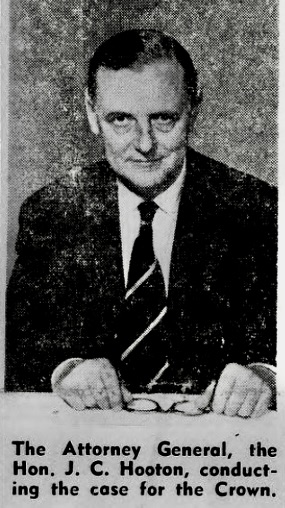
His request was granted and as the preliminary hearing into the Rawlinson murder got under way the possibility grew stronger that Det. Supt. Richard Lewis, of Scotland Yard, would testify during the session.
[Hitherto, it was normal procedure that preliminary hearings were held in open court before the magistrate sitting alone. Only sufficient pertinent evidence to prove a ‘prima facie’ case against the accused needed to be presented by the Crown. Likewise, at a later trial the names of jury members hearing the case was also published as a matter of course.]
Lightbourne consulted his lawyer, Miss Lois Browne, when asked if he wished to give evidence himself or call any witnesses at that time ……
Addressing Lightbourne again the senior magistrate said: "You will be remanded in custody until next Monday ……”
The preliminary hearing on the murder charge of Miss Rawlinson, had included testimony from Det. Supt. Richard Lewis and Det. Sgt. Buck Taylor of Scotland Yard.
At the start of the Preliminary Inquiry (PI), Miss Browne made application that the case should be heard in camera for the same reasons that she had given prior to the Rawlinson hearing. Mr. Hooton said he would offer no objection.
The principal witness was Mrs. Flood, wearing a white blouse, floral patterned skirt and navy-blue cardigan. She gave testimony following a ten-minute break at 10.55 a.m.
Her young, fair-haired daughter entered the courtroom at 11.35 a.m. – and her son gave evidence just after noon. They were followed by Det. Supt. Richard Lewis, of Scotland Yard. He had completed his evidence by 12.23 p.m., after which the court adjourned for lunch.
Accompanied by two policemen, a whistling Lightbourne walked casually down the stairs from the dock to the cells until the court resumed. Other witnesses during the hearing were Sgt. J. C. P. Hanlon, Det. Sgt. John Mullan, Det. Con. R. J. Irons, Dr. Gordon Black, Police Constable John Simmons, Mr. Noel Tucker, Mr. Percy Paynter and Dr. R. E. Shaw.
Lightbourne was later committed for trial in the Supreme Court. It was not known when the Supreme Court trials on the two indictments would commence.
LIGHTBOURNE’S MURDER TRIAL BEGINS IN SUPREME COURT [RAWLINSON]
On Monday, December 7, 1959 Lightbourne's Supreme Court trial on a charge of murdering Dorothy Rawlinson on Southlands Beach, Warwick, on Sunday, September 27, with the Chief Justice, Sir [Arthur] Newnham Worley, on the bench. The Attorney General, the Hon. J. C. Hooton, is prosecuting. Miss Lois Browne, with Mr. Coleridge Williams assisting, is defending.
At the beginning of the proceedings 12 jurymen were selected with three of them replaced after Lightbourne objected. After the remaining panel of jurors had left the court, the Chief Justice told the jurymen that they would be confined until the case was over. The jurymen were publicly named.
Most of the remaining day was taken up with a 2½ hour discussion after Miss Browne had objected to Lightbourne's statement being admitted into evidence. The jury had been sent out shortly after noon.
At 4.0 p.m. the jury returned when Sir Newnham announced that he was overruling the objection made by Miss Browne. The case was adjourned and a police escort of five men accompanied the jury to their accommodations at the Windsor Hotel.
"It is my duty now to open the facts of this case which the prosecution hopes to prove. "I should say here that the object of my so doing is merely that you shall be aware generally of the sort of case it is, what sort of evidence you are going to hear, so that as the evidence is placed before you, you’ll be able perhaps to assess its place in the general picture ……….
"You will, I know, reserve making any sort of judgment on the matter until you have heard the evidence itself; evidence from the witnesses and evidence from certain objects which will be placed before you.
"We have, perhaps, so far not come very near to the man in the dock," Mr. Hooton said. It would be heard, however, that on October 1, Det. Sgt. [Milton Murray] Marsh had taken a statement from the defendant. In this Lightbourne had set up an alibi. He gave an account of his movements, claiming that he believed he was home at the time the murder of Miss Rawlinson took place.
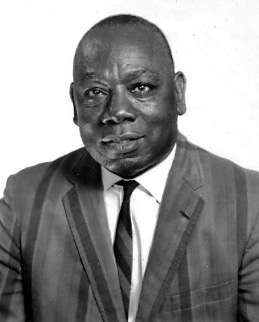
Extensive RG coverage of Mr. Hooton’s opening address to the jury continued – with several salient points briefly detailed below, [in part];
…………. Sgt. Marsh interviewed some young men who work in a livery store on the South Shore Road, which is roughly parallel to Southlands Beach. They said that on September 27 the defendant came into the cycle shop and it was getting on towards dark. His trousers were soaking wet and his shirt, too.
On October 3, the accused gave another statement to Sgt. Marsh. In this he changed his story and said he was down on the beach and "I went swimming in my trousers." He also mentioned meeting the young men in the cycle shop and claimed he had told one of them about going swimming in his pants.
NOTE: It was precisely at this time that the assistance of Scotland Yard had been requested resulting shortly thereafter in the arrival of Det. Supt. Richard Lewis and Det. Sgt. Taylor.
Mr. Hooton referred to an October 30 interview with Lightbourne that the two Yard men had. After some conversation Mr. Lewis left the room. While he was absent the accused asked Sgt. Taylor for a cigarette, and the sergeant walked over to give him a light. The boy took one or two puffs and then said: "They didn't find any stains on my pants at Scotland Yard, did they?"
"I don't know; I haven't seen the report yet," Sgt. Taylor replied.
The Attorney General told the jury that the accused was formally charged on October 31 with the murder of Miss Rawlinson. When cautioned he had replied: "When I left her, she wasn't dead."
Whilst at Hamilton prison on the same day the accused had said to Chief Officer Best: "You fellows can get the rope ready. I only wanted to get even."
To another prison officer, who was keeping the prisoner under observation, he had said: "I killed her, making up for the 12 cuts I received in prison."
The Attorney General continued: “The unfortunate mother of Lightbourne had come to the police station. The accused was told that he need not see her unless he wished. Sgt. Taylor had told Mrs. Lightbourne what to discuss and what not to discuss with her son. But the woman, when she saw the accused, said to him: “Did you do it, son? The girl on the beach?”
The boy had replied ‘Yes.”
Mrs. Lightbourne invited him to say the Lord’s Prayer with her.
Mr. Hooton said that following the interview, Lightbourne was left in the room with Det. Con. Irons. They had no conversation together until Lightbourne said to him: “I could have left the Islands last Wednesday, but I didn’t. I tried to hang myself; I also tried to shoot myself but couldn’t pull the trigger. I don’t mind dying for this. I would be better dead.”
[Mr. Hooton said that] Lightbourne had made another statement to a further prison officer. Mr. Hooton said he understood that Miss Browne would also be objecting to this when he tendered it in evidence.
Concluding, Mr. Hooton again reminded the jurymen that they must judge the case on the evidence and not on what he had told them. "You will bear in mind that you will be making up your minds on the evidence as you hear it," he said. "You will, I am sure, avoid coming to any conclusion before you have heard it in its entirety."
[After completing his opening address to the jury] the Attorney General called his first prosecution witness Mr. W. S. Zuill, of The Royal Gazette. He certified an issue of the paper as being the issue of September 29. This edition carries a photograph of the murdered woman on the front page.
He alleged that Lightbourne had told him, in the presence of Sgt. Frederick Taylor: "I done it, sir. The girl on the beach on Sunday. I bashed her."
He told Mr. Hooton that he had been a police officer for just over 30 years and had arrived in Bermuda on October 5 to be in charge of the Rawlinson murder investigations He had been accompanied by Det. Sgt. Taylor, also of Scotland Yard's Murder Squad.
Q. "On October 6. where did you go?" asked the Attorney General.
A. "I went to Southlands Beach with Det. Inspector [Oliver] Trott and other officers," the Superintendent replied, adding that he examined a spot on the beach pointed out to him.
Q. "Do you know the defendant?"
A. "Yes."
Q. "Where did you first see him?"
A. “I first saw him on October 17 at police headquarters.”
Q. “Was there anybody else present?”
A. “Yes, Sergeant Taylor was with me.”
Q. “What did you tell Lightbourne?”
A. "I introduced Sgt. Taylor and myself to him and said we were police officers from London. I told him that we had come to help to find out what had happened to a woman named Rawlinson at Southlands Beach on September 27. After some further conversation I asked him if he could help my inquiry. He said: 'No'."
Q. "Did you say anything further to him?"
A. "Yes. I told him that after I had finished my inquiry I would see him again."
Q. "What happened to him then.”
A. “Well, he went away. Actually, I went with Sgt. Taylor to his house and took possession of a shirt, and left him there."
Q. "Did you, in fact, see him again?"
A. "Yes. I next saw him on October 30 at the same place: police headquarters at Prospect, with Sgt. Taylor. I reminded Lightbourne that I had seen him before. I introduced the subject of what the interview would be about. The time was then 10.45 a.m. At about 12.50 p.m. I got up from where the interview was taking place and walked out of the room. I came back a few moments later. When I returned Sgt. Taylor said to me, in the presence and hearing of Lightbourne: ‘I think he wants to tell you something he has remembered.' I said: 'Yes, what is it?'
I asked: 'What?' And he said: 'The girl on the beach on Sunday. I bashed her.'
The Yardman continued:
"I then cautioned him, my lord. I wrote the caution down on paper. I explained it to him and read it back to him pointing out each word as I read it back, and I asked him to sign underneath the caution, which he did. After the statement was concluded, I wrote down everything he dictated as he dictated it. After it was completed, I turned towards him and pointed to each word as I read it back. I made corrections as I read it back and asked Lightbourne to initial each one as I came to it. His initials are on each page. He signed it as correct in my presence and in the presence of Det. Sgt. Taylor.
Q. "Sgt. Taylor, was present throughout?" asked Mr. Hooton.
A. “Yes sir.”
Addressing the jury Sir Newnham said: "Well, gentlemen, I shall have to ask you to retire as I hear evidence on this statement which has been made and submitted as evidence."
The jury then retired, and on the question of the statement Miss Browne cross-examined Mr. Lewis for nearly an hour.
When it was time for the luncheon adjournment, Sir Newnham asked the Press to use discretion on evidence given during the absence of the jury. He explained that, while the jurymen would be confined they would still have access to newspapers, and an account of the proceedings while they were out of the room might tend to prejudice their views on the case.
The court reconvened at 2.30 p.m. and the jury again were asked to retire to the jury room. Sgt. Frederick Taylor gave his evidence regarding the circumstances and conversation leading up to Lightbourne’s statement. He was cross-examined at length by Miss Browne.
At 4 p.m. the jury were recalled and Sir Newnham announced that the statement could be admitted into evidence. Supt. Lewis then read the statement as follows:
"I have been told that I am not obliged to say anything unless I wish to do so and that anything I do say will be taken down in writing and given in evidence." (signed) Wendell Lightbourne.
"I want to get it off my mind. I done it. I can't go to heaven now. I went swimming first on Atlantic Beach. I walked along the beach to where the girl was sitting on a rock. When I first saw her she was sitting on the sand in front of the beach hut.
"As I was walking up I saw a little girl and a very young boy playing in the beach hut. When the little girl and boy went away towards the road, I walked up to the girl. I had my pants on but my shirt was off. Shoes off. As I was walking towards the girl she got up and walked to a rock. She was in a bathing suit. She had it on. She had a book in her hand. It looked like a story book. It was brown like a law book."
"It was smaller and thinner. I went up to her and said: 'It's pretty rough today.' She said 'Yes’ and we got talking. About different things and the weather and the water. I stood talking and she was sitting.
"I grabbed her costume. It tore off. She went to slap me. She said: 'You rascal, you.'
"As she went to hit me her hand went over my head. She only caught me like this (hand to forehead).
“I hit her. I gave her a backhanded slap. She went backwards towards the bushes. She must have hit her head. Blood came from her and she made funny noises. She made noises like, ow, ow, ow, like that. I didn't like those noises. I only hit her one hard blow and she went back. She had a big long bag by her. It was a paper bag there.”
"I didn't have any intercourse with her. I just ran away. Nobody saw me on the beach. Nobody around. I ran back the same way I came up. Towards Atlantic.
"I put my shirt on down on Atlantic Beach. Then I went to Johnson's and saw Rochester and the others. This statement has been read over to me and is true.
“On the way back from the girl, I had to swim part of the way where the tide was coming by Faraway rocks.
"The girl wasn't dead when I left her. She was lying with no clothes on with her head in the bushes. Her feet were facing the water. She was a long way from the water.
"I didn't put her in the water. I remember I heard on the news on Tuesday, a woman was found in the water and the sharks eat her. It was on the Sunday before that I hit her.
"This statement has been read over to me and it is true." (signed) Wendell Lightbourne.
Statement taken and signature witnessed by me and written down in the presence of Det. Sgt. Taylor." (signed) R. C. Lewis, Supt.
Mr. Hooton informed the court that after the signing of this statement Supt. Lewis had asked Lightbourne, “You are happier now?" to which Lightbourne had replied, "Oh, yes. I have got it off my mind. You didn't think that I was going to tell you, did you"?
Throughout Friday, December 11th Lightbourne gave his evidence in chief followed by a lengthy and revealing cross-examination by Mr. Hooton. He was re-examined by Miss Browne after which, the court heard from surprise defence witness New York psychiatrist Dr. Mildred Maynard before adjourning late in the day. In her evidence in chief, Dr. Maynard described Lightbourne as a mentally sick boy who was “emotionally unstable, mentally retarded and – “to use a lay term – mentally ill.”
On Saturday 12th much argument ensued and sharp differences of opinion arose between expert Crown and defence medical witnesses as the trial entered its sixth day. During a detailed cross-examination of Dr. Maynard, the Attorney General asked her for a direct “yes or no” answer on whether she thought the 19-year-old Warwick labourer was insane, Dr. Maynard replied: “No” and later added: “Not in the usual sense of the word.”
"Wendell Willis Lightbourne, you have been found guilty by the unanimous verdict of the jury of the murder of Miss Rawlinson, a verdict with which I fully concur. "The sentence which the law requires me to pass upon you is that you shall be taken hence to the place from which you came, there to suffer death in the manner prescribed by law."
"Take him out," ordered the associate of the court. There was a rustle in the court-room as spectators craned their necks to watch Lightbourne leave, and order was called.
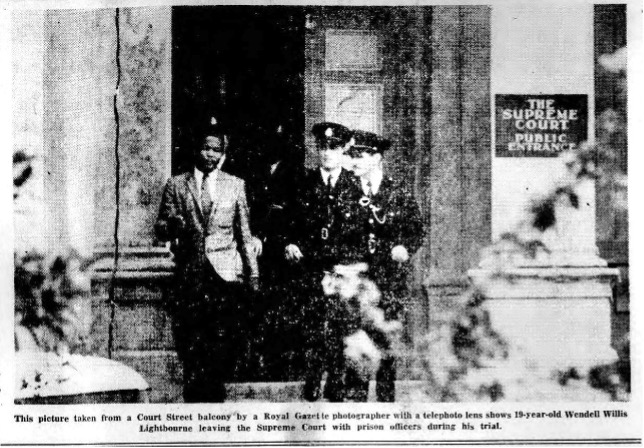
He was scheduled to be executed on December 30, 1959, but the action was variously postponed pending a report by three psychiatrists flown in from Britain who determined that he was mentally unfit. Following their report, Lightbourne’s death sentence was commuted to life imprisonment, to be served in England.
1960
On Wednesday, February 3, 1960 Lightbourne was flown to the U.K. on a scheduled B.O.A.C. Britannia passenger flight for imprisonment at an unnamed “appropriate penal establishment.”
[It was later determined that he was incarcerated at Parkhurst prison on the Isle of Wight. Parkhurst is designed for ordinary class prisoners, prisoners sentenced to preventive detention, and "star" class prisoners transferred for medical or other special reasons. "Star" prisoners are those who have not been in prison before or who are considered unlikely to have a bad influence on other prisoners.]
Lightbourne’s transfer to a British prison occurred before the introduction of the 1968 Bermuda Constitution Order at a time when Bermuda was still governed by the old colonial rules and regulations.
Although never charged, Lightbourne was widely rumored to have possibly had a connection to the murders of Dorothy Pearce and Gertrude Robinson who were both raped and beaten to death in 1959 along Bermuda’s “Murder Mile”. Although investigated by Scotland Yard, both murders remain unsolved to this day.
[Considerable public discussion was reported during the early months of 1960 concerning the disposition of the remaining unsolved Warwick murders. No-one was ever charged in any of these cases.]
1966
BRUTAL ATTACK ON WOMAN AT ‘THE ARCHES'
At a time when many women of the Colony were expressing their concern by bolting and barring their doors by day as well as by night, the probe into the five-day-old brutal attack and rape of an 87-year-old spinster in Paget parish on January 28th 1966 led to a decision by the Executive Council to call in Britain’s top crime-fighting force – the Metropolitan Police, New Scotland Yard, to assist the local C.I.D. in their investigations. Arriving within days by air, Yard detectives Superintendent Maurice Walters and Sergeant Bob Chalk engaged the considerable scientific assets available to them at the Metropolitan Police laboratories at New Scotland Yard and, working in conjunction with local officers, their enquiries soon led to the arrest of Eric “Eggs” MacDonald Trott who was first charged before the courts on March 2nd 1966.
In late May, after a 10-day trial, the jury found Trott guilty of rape and attempted murder. Interestingly, Trott pleaded guilty to wounding police sergeant David Parsons with intent to cause him grievous bodily harm.
Editors note - CLICK HERE to read a personal account by P.C. Nick Hall who had attending the scene of the stabbing where he rescued Sgt Parsons and arrested "Eggs" Smith at the scene. The account is contained in a "Then and Now" article written by Nick Hall and appears just below P.C. Hall's description of the BELCO riot.
Meanwhile, local C.I.D. chief Superintendent Fielders revealed to the Royal Gazette that Miss Tucker, who was in the hospital’s intensive care ward with a fractured skull, fractured upper and lower jaws and multiple bruises, had “not said anything that I could tell you.”
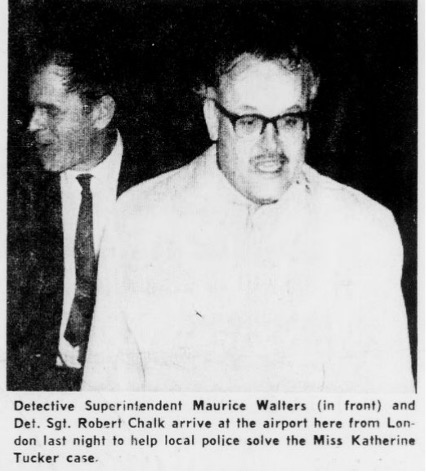
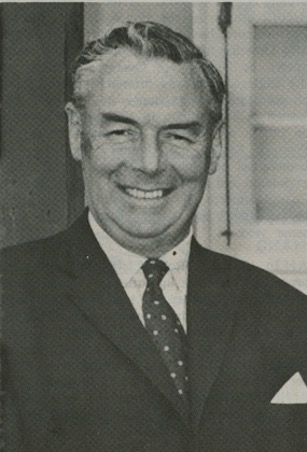
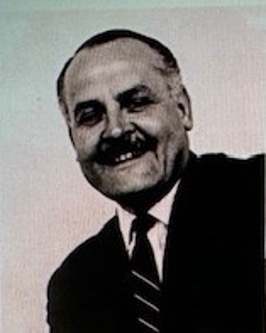
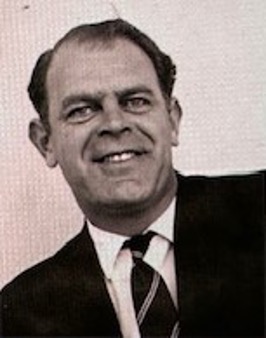 Det. Sergeant Bob Chalk
Det. Sergeant Bob Chalk
By Tuesday, February 8th there had still been no comment in the Tucker case with police still declining to provide any details of the “significant development” in the case they announced on Saturday.
Meanwhile, there were persistent rumours throughout the Colony that a prime suspect in the case was in police custody.
The attack had been called by the Governor Lord Martonmere, a “revolting” crime and the head of the C.I.D., Superintendent Richard Fielders, said that it was the worst attack he has seen in his police experience on a person who has survived.
On Monday night February 9th, Detective Sergeant Leslie Waddell, a forensic officer with the Bermuda C.I.D., carried “more than one” exhibit to London. Police remained ‘tightlipped’ except to say that their enquiries “were still going full steam,” and that they were “quite satisfied” with the progress they were making in the investigation.
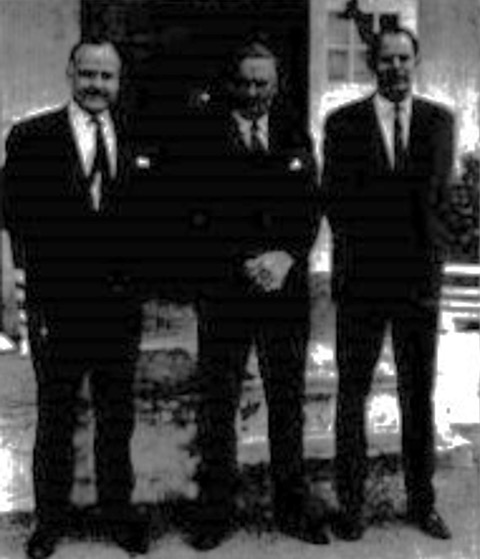
When asked if police statements last week had been over confident he replied: “I'm sorry, I can’t answer that. I can’t make any comment on that at all.” He added his belief that there were “extremely good” relations between the press and the police here however, before admitting that the Tucker case was a difficult one to discuss with the press at this stage of the investigations.
He added that he had no desire to be difficult and added that a premature announcement could prejudice the case. Superintendent Walters said that he thinks the public are more co-operative here than in the United Kingdom. He said that, speaking of the Tucker case, he had found the local public "extremely cooperative.” He added that people themselves had come forward with very valuable information.

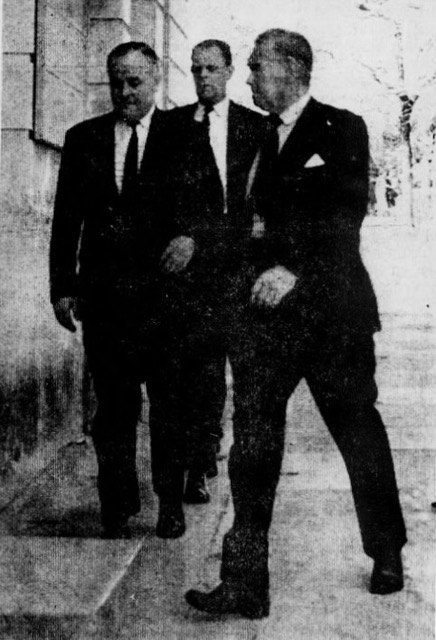
After reading the charges the magistrate said: "It will be necessary to hold an enquiry into these offences.”
At this Trott shouted to Mr. Lownie: "Can I tell the truth?"
After police prosecutor Inspector J. F. Mullan asked for a remand in custody for 14 days, Trott again said to Mr. Lownie: "I want to give the truth about the whole thing" and added later, "Why can't I give the truth?"
Again Mr. Lownie told Trott he could not take a plea and Trott shouted back: "You are trying to create something here.”
Setting the indictable enquiry [the Long Form Preliminary Inquiry] for February 21, Mr. Lownie told Trott: "I am not trying to create anything."
Then, as he was being led from the dock. Trott shouted over his shoulder to Mr. Lownie: "I am not expecting nothing from you devils anyway."
Trott was led downstairs to the waiting police van in which he was shuttled back to gaol.
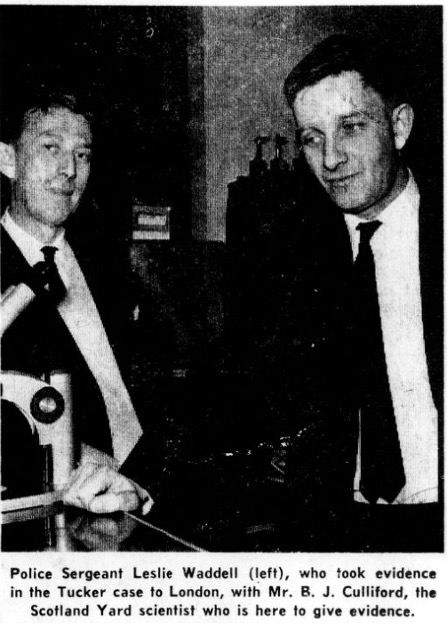
On the first day of testimony [which was open to the public] the police witnesses included Sgt. David Parsons; Supt. Richard Fielders, head of the C.I.D.; P.c. Neville Darrell; D/Sgt. Sinclair Bean; Dc. Michael William Palmer; together with Dr. Terrance Wickham, pathologist at the King Edward VII Memorial Hospital.
Instead, the magistrate, the Wor. E. R. Raymond Bond, the Attorney General, the Hon. J. C. Summerfield who is conducting the hearing for the prosecution, Mrs. Lois Browne-Evans M.C.P., who is representing Trott, and other court officials went to her hospital bedside and took her testimony there.
Miss Tucker gave her evidence from a wheelchair on the third and last day of the preliminary hearing against Trott.
Having heard Miss Tucker's evidence the court moved back to Parliament Street to hear the remaining witnesses which included the two-man Scotland Yard murder squad officers. Other police officers who figured prominently in the investigation into this case included Det. Sgt. Leslie Waddell of the fingerprint section of the Bermuda C.I.D., Det. Con. William Pratt, and Brian Culliford, principal scientific officer at the Metropolitan Police Laboratories.
Trott was committed to stand trial in the Supreme Court. He reserved his defence and was remanded in custody for appearance in the Easter Assizes.
Trott was charged separately with assault occasioning bodily harm and wounding with intent to Police Sergeant David Parsons.
There were 39 prosecution witnesses listed to be called in the alleged offences in the Tucker case, including Miss Tucker herself. The case was the last one set down on the calendar. Witnesses include Detective Superintendent Maurice Walters and Det. Sgt. Robert Chalk, the Scotland Yard men flown here to investigate the case.
[There was comprehensive reporting by the Royal Gazette over the 10 days of trial which provided more detail]
The following day the three Scotland Yard men arrived to join prosecution witnesses at the trial then underway.
Ten trial days later, on Wednesday, May 25th the prosecution counsel [the Attorney General’s speech lasted for about four hours] and the defence had each delivered their closing speeches to the jury.
The Chief Justice told the jury, “With the mass of evidence, I must have some time to complete my task.” He said he would probably sum up and give the case to them on Friday, taking tomorrow to prepare his summation.
The 35-year-old ex-boxer and Mid-Ocean Club houseman listened impassively as the judge handed out the punishment, and quietly left the dock escorted by five prison officers.
After Mr. Thomas Forster Cooper, foreman of the 12-man jury, told the court that the panel had found Trott guilty of raping Miss Tucker and attempting to murder her, by a majority verdict, the Chief Justice asked Mrs. Lois Browne- Evans. M.C.P., counsel for the defence, if she had anything to say. She replied that while the jury were considering their verdict, she had spoken to her client. As a result of what he told her, she had nothing to say.
After the verdict Mrs. Lois Browne-Evans, who together with Mr. Charles Vaucrosson had been criticized earlier in the day by the Chief Justice for her handling of the defence, told the RG that an appeal was possible. “We are going to get a copy of the judgement so I cannot say yet whether we will appeal.”
To reach their verdict the jury retired for more than three and a half hours, following a near four-hour summing up by the Chief Justice.
On the rape indictment he sentenced Trott to 20 years in prison and 12 strokes of the cat-of-nine-tails, and on the attempted murder charge 10 years, the sentences to run concurrently.
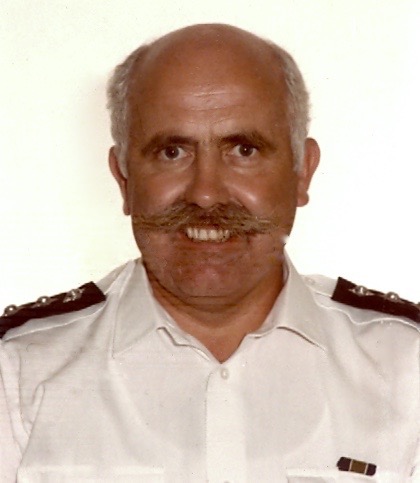
A full report of the Chief Justice’s summing up to the jury appears elsewhere [in the Royal Gazette]
Mrs. Lois Browne-Evans, M.C.P., counsel for Eric “Eggs” Trott who received 25 years in gaol plus 12 lashes of the cat for attacks on Catherine Tucker and Catherine Trott and for stabbing Police Sgt. David Parsons, said yesterday she would be appealing.
Said Mrs. Browne-Evans: "I have written asking for a copy of the judge’s summing up. I must have this to lodge an appeal.” An appeal, she said, could cost anything from £1,000. Already several have donated money to a private fund to launch an appeal, but Mrs. Browne-Evans would not reveal how many persons have contributed or how much has so far been accepted at her office.
“But,” explained the lawyer, “the amount is far from enough at the moment.”
1969
INVESTIGATION OF SERIOUS FRAUD AT KING EDWARD HOSPITAL
At a time in Bermuda when offences of embezzlement were virtually unknown and the Bermuda police was devoid of a forensic fraud investigation unit, it transpired that high-level government influences contributed to the manner in which enquiries proceeded in the matter below, leading as it did to a formal request for the assistance of Scotland Yard officers from London's Metropolitan Fraud Squad.
Yard detectives Chief Inspector Bill Collins and Sergeant Roy Penrose arrived in Bermuda within days of their call and commenced to forensically examine the accounting practices of the hospital’s administrator regarding his personal overtime payments together with other related financial transactions under his remit.
In what became known as the “Challinor affair” the rather complex investigation eventually led to Philip James Challinor and another, jointly facing 22 theft, fraud and conspiracy charges at their trial in the Supreme Court - at which two serving politicians also gave evidence. The earlier pre-trial long-form preliminary inquiry was plagued with unusual circumstances and tactical delays driven by legal maneuvers designed to obtain the most favorable positions for both the Crown and defence.
Earlier in the day he had been questioned on his overtime and money spent on the hospital. Mr. Challinor - at the centre of a row raging over the training of Bermudian girls in England - had been asked not to leave because of the probe. The dramatic move came after it was revealed that the 48-year-old administrator had received permission earlier that day to leave immediately rather than work out his already shortened term of office. Mr. Challinor was on the point of packing his bags to catch the evening flight to Britain when C.I.D. chief Supt. Frank Hammond visited him at the hospital.
During the afternoon he had been questioned by two government officials. He later told The Royal Gazette: “I cannot think of anything for the life of me what they are questioning me for, although I have been racking my brains.”
The sensational news broke after a day of developments at the Paget hospital. Mr. Challinor, who took over from the previous administrator in December of 1967, had already told the Government that he was quitting over the training disagreement and said that he was leaving at the end of March, rather than at the end of June when he originally intended to go. Then, yesterday morning, he said, he had a meeting with two members of the Hospital Board at which it was mutually agreed that he could leave at any time.
But in the afternoon, according to Mr. Challinor, the Hon. John Plowman member for Government Organization and Mr. Quinton Edness, M.C.P., arrived at the hospital to tell him that they wanted to inquire into his administration over the past 14 months.
Later that afternoon Detective Superintendent Hammond had arrived to put several questions to Mr. Challinor on his overtime pay and money spent on the hospital. It was then that Mr. Challinor found out that Mr. Plowman and Mr. Edness were questioning his authority on spending money. He said: “A vacuum seems to have been created over nursing assistants going to train in England and it seemed to be pointless going on. …
Mr. Challinor said he himself charged for 38 hours a week plus any additional overtime work. The accountant, he said, was paid the same, as well as the rest of the hospital staff. The Board, said Mr. Challinor, meets once a month “and nothing financial goes to them, it never does.” The administrator went on to explain that Superintendent Hammond said in view of the inquiry by Mr. Plowman and Mr. Edness would he please stay on the island and not take the night flight. Mr. Challinor agreed to do this and told the Royal Gazette that he was considering seeking legal advice, but implied that it might be rather difficult to find unbiased representation in Bermuda.
Questioned on the possible inquiry he said: “I have a clear conscience.” Mr. Challinor claimed that his position carried the authority to spend money on hospital administration. “I cannot think for the life of me what they are questioning, although I have been racking my brains.”
It is Mr. Challinor’s intention on returning to England to help the Bermudian trainees as much as possible. Formerly he was secretary of the group of hospitals to which the girls would be going. He did not expect to be in his office today.
Mr. George Robins, Commissioner of Police, told the Gazette: “There is an official police investigation concerning the matter of overtime. We are not concerned with the administration of the hospital, that is a matter for the hospital Board.”
Mr. Challinor yesterday called his wife in Shropshire, England, telling her that he was flying home on B.O.A.C.’s 8:15 p.m. flight from Bermuda. He had booked a seat on the aircraft, presumably after the agreement with the two Board members. It was last month he clashed with the Government over the question of Bermudian nursing assistants training in the U.K. He holds the view that the girls should be seconded with pay and should have their air fares paid as well. The Board have said that the British Government should pay for the air fares.
First news of the unusual step came shortly before the pairs arrival when the Bermuda Government issued a statement saying they had “invited” the London Metropolitan Police to assist local detectives with investigations being “conducted at the King Edward VII Memorial Hospital.”
Police said they were probing into the overtime of former hospital administrator Mr. Philip James Challinor, who has resigned. And Mr. Challinor has said two legislators told him they were investigating the administration of the hospital.
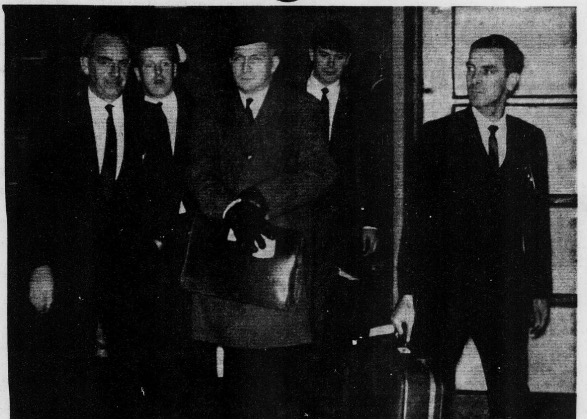
The man had been arrested on Sunday morning and was later released overnight on [police] bail totaling £2,500, made up of two sureties of £1,000 each, with the man being freed in his own recognizance of £500. The police spokesman had made the statement when being asked about the investigations by two Scotland Yard detectives who flew into the Colony on Friday. They had been invited to Bermuda to assist local police with investigations being carried out at King Edward VII Memorial Hospital.
[It later transpired that Philip James Challinor was otherwise known as James Henry Leeke Challinor]
After the charges had been read, a series of ‘fiery’ legal arguments ensued before Mr. Lownie involving Mr. A. W. Sedgwick, Solicitor General, who appeared for the Attorney General, and Mr. Charles Vaucrosson, Challinor’s counsel. With Mr. Vaucrosson were two of his associates – Mr. Walter N. H. Robinson and Mr. D. H. L. Chandler.
At one point, Mr. Vaucrosson reminded the court that Mr. Challinor was now unemployed. Counsel suggested that if the prosecution intended to see “that justice is to be done,” they should attempt to have the case heard as soon as possible, and come up with the alleged injustices “being perpetrated on Mr. Challinor.”
Mr. Sedgwick did not like this last remark, either, to which Mr. Lownie commented that such remarks “have no effect on the matter in hand.” He decided that bail would be extended until 9.15 a.m. on February 24, and fixed a tentative date for the preliminary magistrates’ court hearing on March 10. [Later increased to the 11th and 12th]. Mr. Sedgwick realized this was subject “to investigations being completed.”
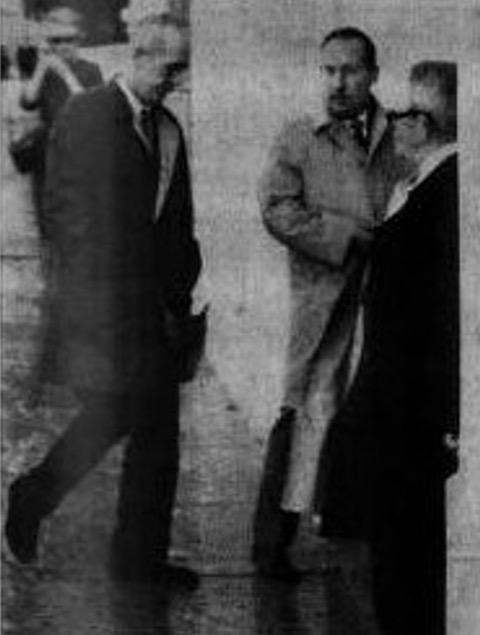 Mr. Philip Challinor, on the left of the picture, turns to enter Hamilton
Mr. Philip Challinor, on the left of the picture, turns to enter Hamilton
The reason: the matter is sub judice. Last Wednesday the Hon. Hugh Richardson gave notice that today he would be moving that a select committee be appointed to investigate the facts surrounding the Administrator’s resignation. Since then, however, a court case has begun.
On that date however, the preliminary hearing … against … Philip James Challinor and accountant David Sawden Wheatley, was adjourned – for the second time. The hearing had originally been scheduled for that Monday…, when the two men would have faced 22 charges involving more than £50,000. But the proceedings were adjourned following a request from Mr. Ian Ramsay, a noted Jamaican Queen’s Counsel defending Challinor…
Mr. Ramsay spoke of a mystery event of “far reaching significance.” At the hearing the request for a further 24-hour delay came from [Solicitor] General Mr. Anthony Sedgwick, in the absence of the Attorney General. The decision to apply for the adjournment was made after discussions between the Attorney General and Mr. Ramsay, who commented that he thought it a proper thing for the Crown to further consider its position. Yesterday’s hearing lasted exactly seven minutes, before the case was adjourned … Both men were released on bail totaling £2,000 each.
Mr. J. C. Summerfield said as he made the announcement, “I cannot continue any longer to also act as counsel and have therefore handed over the prosecution to Mr. (Francis) Daly who is not so involved.”
Mr. Summerfield who has been holding talks with defence counsel, Mr. Ian Ramsay Q.C. since the latter's arrival in the colony over the weekend, told the Wor. R. H. Lownie in Hamilton magistrates court that a “fairly lengthy" adjournment had now become necessary and asked for an adjournment until March 31. The former prosecutor's request apparently came as no surprise to Mr. Ramsay, who responded simply: "The defence will make no comment, save to say the 31st of March is agreeable."
Minutes before the scheduled opening of the preliminary inquiry into the 22 charges, Mr. Ramsay stood in the magistrates court several feet in front of the seated defendants, and continued his discussions with the Attorney General. They were joined briefly by two Scotland Yard detectives, and remained in conversation until the arrival of the senior magistrate. Addressing Mr. Lownie, Mr. Summerfield announced his position: “Defence counsel Mr. Ramsay has represented to me that by reason of my involvement in a certain matter, which is the subject matter of the notice to produce and which is related to these proceedings, I may be a material witness at some stage of these proceedings."
Adjournment was granted until March 31 and Wheatley and Challinor were released on bail until that time. Mr. Ramsay left the colony that day at noon and will return for the resumption of proceedings. He is being briefed by the firm of Charles Vaucrosson. The court had been crowded with the two Scotland Yard detectives, lawyers and doctors on each of the three mornings when attempts were made to proceed with the preliminary hearing.
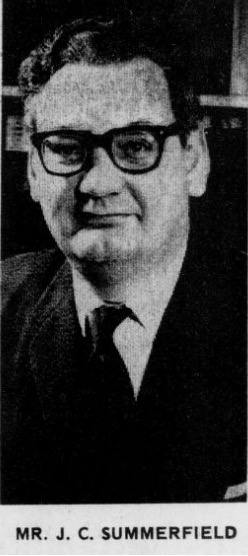
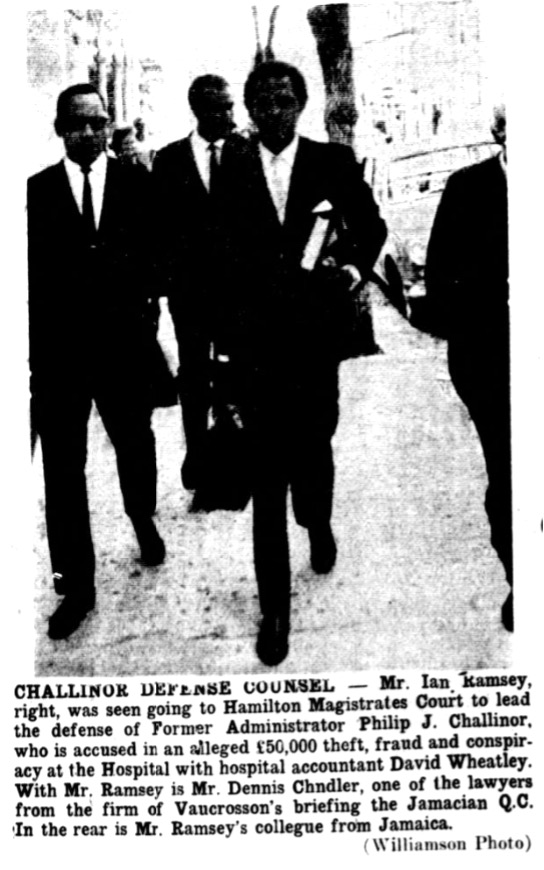
The RG reported that the charges against Challinor and Wheatley now involved over £50,000; and steps were being taken to arrange for someone else to be at the court in the event that Mr. Ramsey found himself unable to return to the colony. This was the position of the defence as barrister Mr. Charles Vaucrosson requested the adjournment. Mr. Vaucrosson, whose law firm had been briefing Mr. Ramsey, objected to the suggestion that the adjournment only be for 24 hours. The defence could not hope to have its position clarified within so short a time, he said.
Crown counsel Mr. Francis Daly objected to the further delaying of the case's opening. The senior magistrate however, granted the adjournment and released both men on bail again. Estimates are that once underway proceedings in the lower court will last for anything up to two weeks.
Subsequently, Mr. Thompson appeared in magistrates court the following day for the scheduled preliminary hearing into the charges facing his client – as did Mr. Ramsay who found himself able to return to the Colony in time for the scheduled preliminary hearing on April 2.
Crown Counsel Mr. Francis Daly told the senior magistrate Mr. Lownie – and a packed magistrates court – that there were now 28 charges against Challinor. The additional charges all allege that Challinor, with intent to defraud the hospital board, was responsible “for the use of hospital purchase orders to buy airline tickets for people not entitled to them.” The detailed charges were read out in court.
The first day’s proceeding lasted approximately 5½ hours and adjourned at 4.15pm. In the witness box all day was Mr. John Russell Steinhoff, a partner in the local accounting firm of Butterfield and Steinhoff.
The court adjourned after Mr. Steinhoff had completed his evidence, and due to go into the witness box the next day was Lieut-Col. J. Brownlow Tucker, M.C.P. chairman of the King Edward VII Hospital Board.
Prosecutor Crown Counsel Mr. Francis Daly led his second witness through the alleged evidence which was taken down in long hand by the senior magistrate. At the finish the magistrate told Col. Tucker to take a chair while he read back the evidence. It took more than half an hour.
Wheatley was represented by Mr. John Ellison. The two defendants sat immediately behind their lawyers making notes of the proceedings. Challinor frequently handed notes to Mr. Thompson. Every public seat was taken when the hearing began, but there were several empty seats as the day wore on. Over 40 exhibits had been presented in Mr. Steinhoff’s evidence and Scotland Yard Fraud Squad Det. Sgt. Roy Penrose and a local officer were kept busy handing out copies of the exhibits to the lawyers.
“Even though they were “worked to the bone” on the enquiry, they did manage to see some of the beauty spots of the Islands. On one particular boat trip Roy Penrose, in trying to save the ninth life of a stranded cat, sustained a nasty cut to his hand from some of the coral rock found around our shores. Come again Roy, but try fishing next time!’
Next in the box was barrister the Hon. Arthur A. Francis, chairman of the Hospital Board. He took great pains with his replies to questions both from the defence and prosecution, as most lawyers do when they find themselves on the stand.
Those witnesses giving evidence included Quinton Lancelot Edness; Dr. Theodore Stuart Outerbridge; Morris Alvin Gibbons; Patricia J. Ratteray and James Benson Ferguson.
Meanwhile, Jamaican Queen’s Counsel Mr. Ian Ramsay had returned to Bermuda once more after having been absent for the past four days of lower court proceedings. Mr. Ramsay, who was accompanied in court by his junior, Mr. Howard Hamilton, resumed his work as Challinor’s defence counsel, together with Senator Dudley Thompson.
Nine more witnesses completed their testimony on the sixth day of the preliminary proceeding including Scotland Yard detective, Chief Inspector William Collins who testified for just over half hour. This was only after the hearing’s pace was accelerated when the defence relaxed its vein of cross examination, interrogating but few of the witnesses, and these only briefly.
The last witness to testify was Superintendent of the Criminal Investigation Department, Francis Hammond. Testifying for more than two hours, the C.I.D. head was the last of 35 witnesses called for prosecution evidence in the case linking Philip James Challinor and David Sawden Wheatley in 22 charges of theft, fraud and conspiracy. Neither Supt. Hammond, nor Dc Thomas Cassin, who preceded the C.I.D. head in the box were cross-examined.
The magistrate's decision on whether he should send the case to Supreme Court or dismiss the charges against Challinor and Wheatley, will be made following Mr. Ramsay’s submissions. This decision is expected to come later in the week when the magistrate has reviewed the case in full.
On Friday, April 11th, the Bermuda Recorder reported that the Crown had completed the evidence in the preliminary hearing in the Challinor-Wheatley case and that the Senior Magistrate R. H. Lownie would decide whether a High Court trial should be ordered after the defence makes final submissions on Monday [14th].
It was observed that throughout the entire inquiry involving over a hundred exhibits and several thousand lines of typewritten documentation, Crown Counsel Mr. Francis Daly, had remained unruffled by the occasional interjection of a defence counsel, the clamour of a closing door, or the dull drone of an automatic air conditioner.
Counsel for Mr. Challinor, Mr. Ian Ramsay, Q.C., asked Mr. Lownie to “give the most careful consideration” to all the evidence before him before actually coming to a final decision. In his submission, which lasted two hours, Mr. Ramsay said the Crown did not succeed in making out a prima facie case and “there is no case to answer.”
Mr. John Ellison was of the same opinion as Mr. Ramsay and on behalf of his client, Wheatley, submitted briefly that no prima facie case had been made out.
There had been 35 witnesses who testified for the Crown during seven days of the eight-day-long preliminary inquiry.
Magistrate the Wor. R. H. Lownie, who presided over the lengthy preliminary hearing, ended the inquiry in less than five minutes when he handed down his decision. With regard to the six charges facing Challinor alone, concerning air tickets, Mr. Lownie recommended that the two of these relating to Challinor’s sons, Michael and Philip be amended to charges of theft rather than fraud.
The magistrate said that submissions that there was no case to answer which had been made by Jamaican counsel Ian Ramsey in a two-hour address on behalf of Challinor and by Wheatley’s lawyer John Ellison at first sight seemed attractive but he added they had no validity.
Neither Challinor nor Wheatley spoke after the decision was given. Mr. Charles Vaucrosson, for Challinor, and Mr. John Ellison, for Wheatley, both said their clients would reserve their defence for the Supreme Court.
The Bermuda Government announced that a senior lawyer from the Central Criminal Court in London, known as the Old Bailey, is to arrive in Bermuda within a week's time to conduct the prosecution in the case of the Crown versus Challinor and Wheatley.
A Government statement revealed that Mr. John Charles Mathew was the man who had been briefed in the alleged £55,000 fraud, theft and conspiracy trial … Mr. Mathew was set to arrive on May 15, when [an] application would be made for him to be called to the Bermuda Bar in order to represent the Crown. Mr. Mathew, who had been called to the Bar by Lincolns Inn in June 1949, is at present fourth Senior Counsel out of eight to [represent] the Crown at the Old Bailey.
It was expected that the Supreme Court arraignment would take place on Friday, May 16, and the trial was likely to start on Monday, May 19.
A special jury panel has not been summoned since 1967 when the move was taken for the trial of Eric MacDonald Trott.
The trial was certain to cause a great deal of public interest and a special jury – members who are considered to have above average intelligence – would be selected.
A list of people suitable for special jury duties is submitted every year to the Supreme Court by parish vestries. The move was believed to have been taken in this case because of the mass of complicated records and documents likely to be produced in evidence. The jury are empaneled in the normal manner with the defence being allowed to challenge three jurors for each defendant.
The two men, smartly dressed in grey suits and white shirts, looked tense but answered calmly as the new list of alleged offences was read out.
The courtroom’s public gallery was crowded when Sir Myles Abbott, the Chief Justice, entered to get the session underway. The front portion of the court was filled with legal men, local police and the two Scotland Yard Fraud Squad detectives who had been probing the hospital books and accounts.
The first sign of a legal clash came when the Chief Justice rejected pleas by the defence lawyers to see the list of those to be called for special jury duties. After hearing arguments from both sides, Sir Myles had ruled that it would be better if the list was issued at the commencement of the trial on Monday.
[Much of the remaining trial proceedings were exhaustively covered in detail by the Royal Gazette and are available online for further reference. Local police evidence at the trial including that offered by Scotland Yard Chief Inspector William Collins is reproduced below]
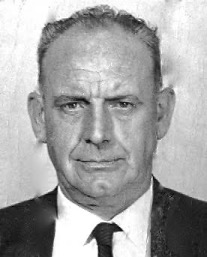
Supt. Hammond said he asked Challinor: "Did you earn about £34.000 in a year?" Challinor was said to have replied: "Yes, but I do not intend to take out of Bermuda anything I have not earned."
In a further statement to Supt. Hammond, Challinor was alleged to have said: “The hospital was chaotic when I arrived. Over staffing. Bad industrial relations. It was the worst hospital I ever met.”
The court adjourned until the following Monday morning with Superintendent Hammond still in the witness box under prosecution examination.
On Monday, June 2nd at the opening of the 10th day, Bermuda Police Supt. Frank Hammond once again entered the box to continue his evidence. He told of interviews with former King Edward Administrator P. J. Challinor. Supt. Hammond asked Challinor if he thought he had authority to dispose of the hospital’s capital assets without reference to the board.
Challinor was quoted as having said [to Supt. Hammond] he had been working such long hours and under such a mental strain that he was not aware he had been paid several large sums of money.
During the interviews Challinor was asked if the hospital’s pathologist, Dr. Terence Wickham, and radiologist Dr. Keith Ashcroft, were aware their salaries had been “inflated” from £10-12,000 for last year.
"There was no question of inflating their salaries,” Challinor was said to have replied.
Earlier, Challinor was said to have stated that "delay after delay took place in the amalgamation of the hospitals (King Edward and St. Brendan’s) by the politicians.”
Next on the stand was Detective Constable Thomas Cassin who said he had taken statements from the pathologist and radiologist. …
An hour before lunch Scotland Yardman, Det. Chief Inspector William Collins, told of an interview he had with Wheatley. The ex-accountant was said to have stated he had no written contract but received just over £3,000 a year salary.
He was asked if he thought that a salaried senior officer was entitled to claim overtime.
"Up till June last year I did not,” he was said to have answered. “I was asked by Challinor what overtime I had worked. He told me to go away and work out my hours of overtime, but he disregarded my figure and wrote down on a slip of paper the number of hours and rate I should claim,” the Yardman quoted Wheatley as saying. Wheatley went on to say that in December last year he flew to the United Kingdom with his wife, the Chief Inspector said.
“The hospital had paid for the tickets,” he was reported as saying. “I never repaid them. Mr. Challinor authorized the tickets.”
Under cross-examination by Wheatley’s counsel, Mr. John Ellison, the detective said he thought Challinor had the more “forceful personality” of the two.
Moving on …
CHALLINOR was sentenced to a total of 6 years and 9 months on 12 charges. But some were to be served concurrently, leaving a term of 4 years and 9 months. WHEATLEY was sentenced to a total of 4 months on three charges, but two month-long terms were to be served concurrently, leaving three months. Neither man had anything to say from the dock.
Chief Justice Sir Myles Abbott recommended to Governor Lord Martonmere that both men be deported from Bermuda when they were released. The men showed no emotion when the sentences were passed.
1971
RAPE AND MURDER AT POMANDER ROAD
One week later, the Chief Secretary's Office stated that "If at any stage the services of Scotland Yard would appear to be in any way helpful in the conduct of the investigation, there would be no hesitation in calling them in, but it is not considered that there is any need to do so at this stage."
Early in the investigation two C.I.D. officers flew to New York in pursuit of a line of inquiry which involved locating an American yachtsman of interest who had left the Hamilton harbour waters on his sailing yacht in the early hours of the morning of the murder. After extensive interviews and the expert use of a polygraph machine the yachtsman was eventually eliminated from the enquiry.
And on July 18th a Scenes of Crime officer flew to London to deliver exhibits in the case to Scotland Yard for further analysis in their forensic laboratory.
Ten days later Commissioner George Duckett, confirmed that Scotland Yard had been asked to assist in the inquiry into the death of the 24-year-old mother. The Commissioner's statement named the two Yard officers as Detective Chief Superintendent Wright and Detective Sergeant Haddrell both of whom arrived for their first time on the Island. Their stated mission was to assist in the ongoing investigations into the rape and murder of Mrs. Burrows.
Durham-born Chief Superintendent Wright (48), is married and has a son and daughter. He lives in Uxbridge, near London and has been with Scotland Yard for 25-years and has been in charge of numerous murder inquiries. This is the first time he has been assigned to a case outside the United Kingdom however.
Sergeant Haddrell is also married and has one daughter. He lives at Orpington in Kent.
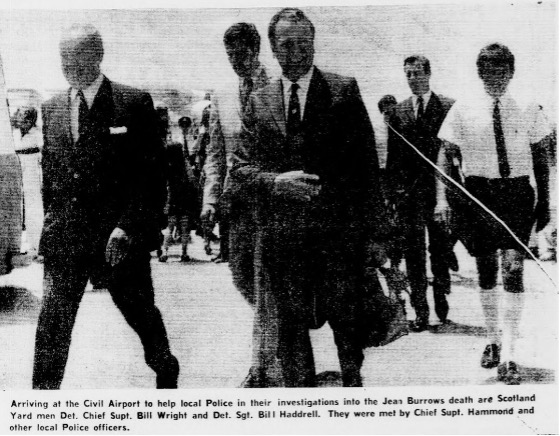
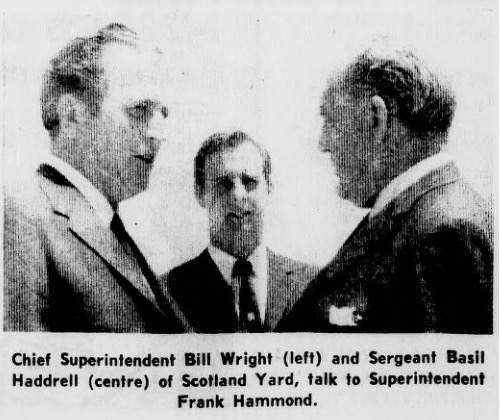
CLICK HERE to read more about the involvement of Scotland Yard during their investigations into the brutal rape and murder on Pomander Road, Paget in 1971.
EDITORS NOTE - The article "Brutal Murder on Pomander Road" written by George Rose, who was directly involved in the the case, provides an excellent account of the successful investigation into the murder of Jean Burrows and the subsquent trial and conviction of Paul Belvin who was initially sentenced to death, which was later commuted to life imprisonment. The article includes aspects of the inquiry never before revealed. The photo below was taken of the Murder Squad team including the two Scotland Yard detectives, Bill Wright and Basil Haddrell, both of whom returned to Bermuda to investigate a series of murders including the murder of Commissioner of Police, George Duckett, and the assassination of H.E. The Governor Sir Richard Sharples.
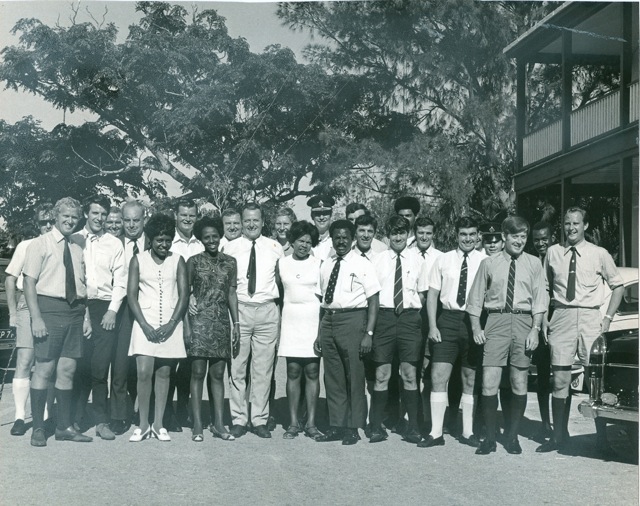
1972
MURDER OF POLICE COMMISSIONER
In the midst of profound changes then occurring within the Criminal Investigation Department of London’s Metropolitan Police Force, Scotland Yard detectives were once again called upon by Bermudian authorities to assist investigations into the cold-blooded murder of the island’s police commissioner Mr. George Duckett at his home during the evening of Saturday, September 9th, 1972.
Within hours of the killing the Acting Governor had telephoned Scotland Yard and specifically requested the assistance of Detective Chief Superintendent Bill Wright and Detective Sergeant Basil Haddrell to assist local officers in the murder investigation. Having prior knowledge of the Island during the preceding year involving the Jean Burrows murder investigations these two detectives arrived for a second time on the afternoon of September 11, 1972.
Yesterday afternoon, two Scotland Yard murder Squad detectives, Chief Superintendent Bill Wright and Detective Sergeant Basil Haddrell, the same officers who conducted the Jean Burrows murder inquiry, arrived from London to lead the investigation into Mr. Duckett’s murder. The two Scotland men were met at the Air Terminal by Mr. Gavin Shorto, Government’s Director of Public Relations, and Chief Inspector William “Sykes” Smith.
Chief Supt. Wright and Det. Sgt. Haddrell, were expected to get down to work almost immediately after their arrival. Chief Insp. Smith said yesterday that they would not reveal any details about the murder until the Scotland Yard officers had decided what they wanted to release.
During the murder trial of Paul Belvin, convicted of the murder of Jean Burrows, the prosecution was in some difficulty in establishing what information could be known only by the murderer and what was general knowledge. Many hours of work have already been put in on the Duckett case. An autopsy was performed on Mr. Duckett’s body on Sunday morning, but no information has been released about how many times he was shot or what type of gun was used.
When asked about a report that Mr. Duckett was shot with a gun with a silencer fitted to it, Chief Insp. Smith said he had no knowledge of this. He would also not give any details about where Mr. Duckett was shot, and could not confirm that he was shot outside the kitchen door of his residence, Bleak House, North Shore, Devonshire.
According to an unconfirmed report, Mr. Duckett staggered back into the kitchen and collapsed there. His 17-year-old daughter, Marcia, was then supposed to have been shot through the kitchen window. Chief Insp. Smith, asked about this report, said: “No comment.” A number of people have already been interviewed by police, but Chief Insp. Smith said he would not call them “suspects”. Mrs. Duckett, who has been under sedation in the King Edward VII Memorial Hospital, has given her account of what happened to police, and Marcia, who is recovering from bullet wounds has also been interviewed. Yesterday, a hospital spokesman said that they were both in a satisfactory condition.
All day on Sunday and Monday as many as two dozen police officers had been searching the area around Bleak House on the hill looking towards the North Shore. Police divers could be seen working along the shore and a small boat with policemen on board was in the area. The road leading up to the house was open again, but no-one was allowed near the house which was set back from the road and surrounded by trees and bushes. Three police Land Rovers could be seen parked in the driveway and, the engine of one was started when an officer used his radio so that The Royal Gazette reporter could not hear what was being said.
The search party, led by Insp. John “Sean” Sheehan, has been working since six o’clock in the morning searching every inch of the grounds around the house. They would not say that they had found anything, but the men were concentrating on an area about 500 yards west of the house. Unofficially, one police officer said that they were “not wasting their time” in a particular area. Chief Insp. Smith said that he had no knowledge that the murder weapon had been found.
Police have also carried out a thorough search of the farm which is directly next door to Bleak House. There is only a short wire fence around Bleak House and it is very easy to get into the grounds. In fact, there is no front gate to the house. Large lights have been positioned in front of the house so that work can continue after dark if necessary. A large number of rumours have been circulating the Island about the murder. It is understood that the outside telephone cables to Bleak House were cut on the night of the murder. Mrs. Duckett is reported to have been able to contact the Operations Room at police headquarters by means of a “hot line” used by the Commissioner. When asked about this, Chief Insp. Smith said: “No comment.”
He denied the rumour that Mr. Duckett’s dog had been shot on the night of the murder. No inquest date has been fixed yet. In a case like this, it is customary for the police to finish their investigations before one is held. Arrangements had not yet been made for Mr. Duckett’s funeral.
Not only the people of Bermuda have been shocked by the brutal murder of Mr. Duckett. Several English national newspapers have sent reporters specially to Bermuda to cover the investigation. The Bermuda Police flag flew at half-mast.
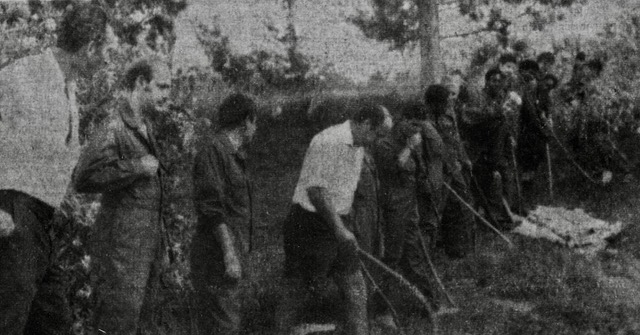
In early December, the two detectives returned to London for a conference but returned again to Bermuda in January 1973 for another six weeks of investigation into the police chief’s murder. They failed to gather substantial clues however and Chief Superintendent Wright decided in February to call a halt to their enquiries and he and DS Haddrell returned to London leaving local detectives to pursue the investigation.
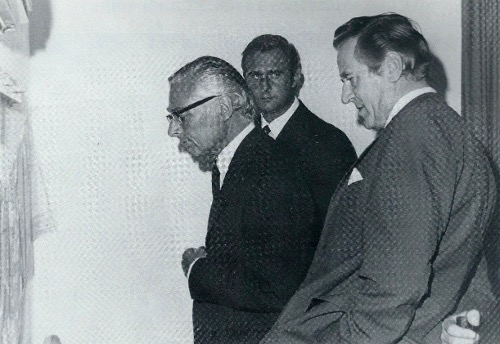
1973
ASSASSINATION OF GOVERNOR AND HIS A.D.C.
Six months after the murder of Commissioner George Duckett, Bermuda was rocked by the assassination of H.E. the Governor, Sir Richard Sharples, together with the simultaneous murder of his ADC Captain Hugh Sayers, in the grounds of Government House on Saturday 10th March 1973.
The next day, March 11th 1973, Detective Chief Superintendent Bill Wright and Detective Sergeant Basil Haddrell returned again to the island to continue their enquiries into the murder of Commissioner Ducket – and now – into the assassination of H.E. the Governor together with the murder of his ADC, followed later by the connected killings of two civilian men in an armed robbery at a grocery store.
Assisting them were members of the UK’s Regional Crime Squad headed by Commander John Morrison. In all nine high-ranking detectives had arrived in Bermuda by Wednesday 14th March to assist with enquiries. This team of detectives was the largest ever sent by London on a case overseas. They were said to have been members of the Yard’s Flying Squad (C8) which had been formed after the First World War in order to provide a mobile body of detectives for special duties to deal with particular outbreaks of crime. As I recall, they did not remain in the island for more than one week before returning to London.
‘The 52-year-old Morrison was the senior officer in the investigation. He had been Deputy Coordinator of the Regional Crime Squad in the UK since December 1972. He was previously Deputy Head of Scotland Yard’s A1 Branch which investigated complaints against police officers. He was also a member of Scotland Yard’s C1 Murder Squad and both he and 52-year-old Chief Superintendent Wright had visited Bermuda previously to investigate the Jean Burrows murder followed by Commissioner Duckett’s murder. Commander Morrison had received 17 commendations during his career.
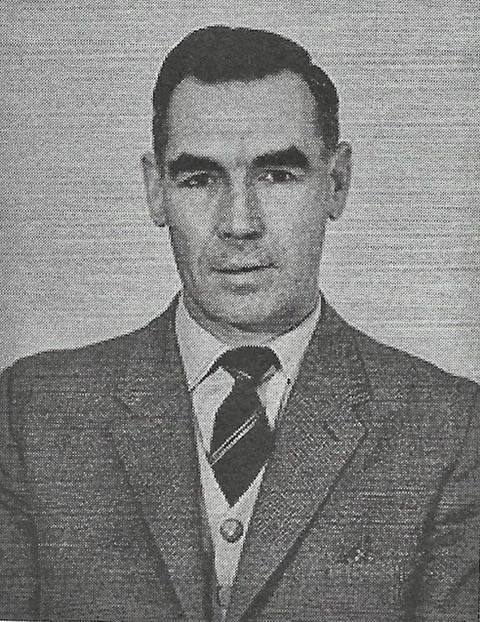
Also attending was Chief Superintendent Gordon Powell a member of the UK’s Regional Crime Squad in his capacity as a member of the Fingerprint Section. Another member of the team was Detective Sergeant Nick Birch who had narrowly escaped injury when a bomb blew up outside London’s Old Bailey Courts a week before his trip to Bermuda. The 36-year-old Birch had just parked his car behind the bomb car, planted by the IRA, when it exploded. The explosion had hurled Birch across the street and wrecked his two-week old Triumph sports car.
Two Scenes of Crime officers, Detective Sergeant Colin Rumsby [with whom I became friendly during his stay on the Island] together with forensic expert Arthur Sabine arrived in Bermuda on April 13th, as did a fingerprint expert, Detective Superintendent Sydney Draper and four men from the Flying Squad. (Ayton)
The Bermuda Police believed at the time that the gunman may have left the island by sea or air and some weeks later the FBI and Canadian Police were enlisted to help in the manhunt for the killers.
EDITORS NOTE - We do not, at this point in time, have a comprehensive and specific account of the extensive investigations into the murders of Commissioner of Police, George Duckett, who was shot and killed at his home in Devonshire on 9th September 1972; the assassination of H.E. The Governor, Sir Richard Sharples and the murder of his ADC Captain Hugh Sayers both of whom were shot and killed 6 months later in the grounds of Government House, on 10th March 1973; and the callous murder of two men, Mr. Victor Rego and Mr. Mark Doe who were bound, shot and killed at the Shopping Centre in Hamilton on 6th April 1973.
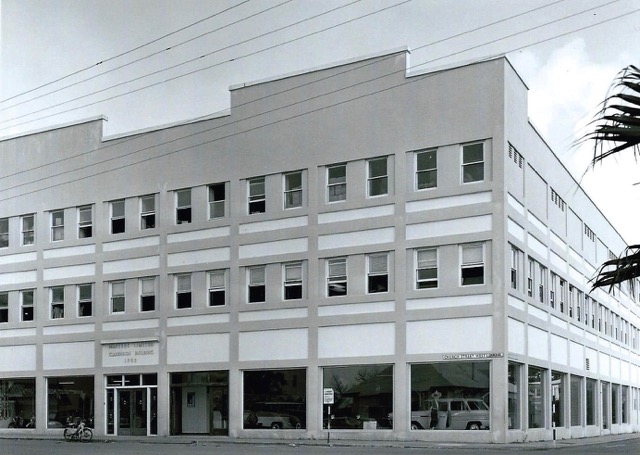 Masters Clarendon Building in 1973
Masters Clarendon Building in 1973
It was just 2 weeks after the Masters robbery that the bodies of two men, or rather a man and a young teenager, were found bound, shot and killed in the Shopping Centre. Not surprisingly, the investigation into the Masters armed robbery became interlinked with the other murders, all involving guns, and evidence gained from the Masters robbery proved vital in leading to success in the murder investigations as clearly outlined in the "Follow the Guns ......" article.
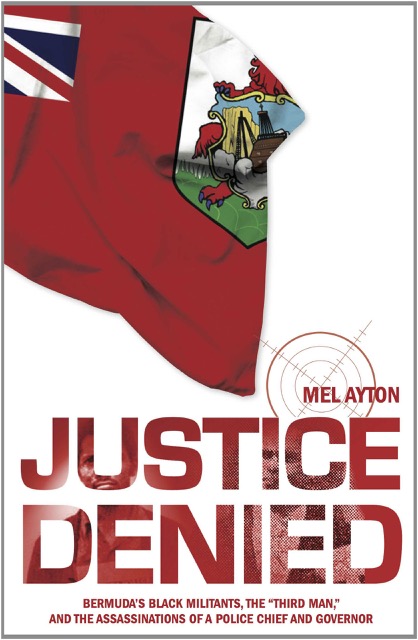
For anyone seeking more information about this terrible series of murders and crimes committed in 1972 and 1973, which resulted in the conviction of Erskine "Buck" Burrows and Larry Tacklyn, who were both hanged in 1977 for their involvement, you can read the book "Justice Denied" by Mel Ayton who at one time worked as a prison officer here in Bermuda. Mr. Ayton has authored 20 books including "The Kennedy Assassinations: JFK and Bobby Kennedy", "The Man who Killed Martin Luther King", and "Hunting the President: Threats, Plots and Assassination Attempts - From FDR to Obama".
Amazon's description of "Justice Denied" reads as follows:-
Justice Denied - Bermuda's Black Militants, the 'Third Man' and the Assassinations of a Police Chief and Governor is the first full account of the 1972/1973 assassinations of Bermuda's Governor and Police Chief. The book includes a Foreword by Dr. Carol Shuman, psychologist, former newspaper reporter, editor and author.
During the 1970s, a black power organization in Bermuda who modelled themselves on the American Black Panthers, conspired to bring about social change "by any means necessary", including assassination. The struggle for equal rights in Bermuda during this period both imitated events in the United States and was heavily influenced by them, especially the role American black militants played in encouraging Bermuda's youth to challenge the white power structure on the island. Bermuda became the first nation to suffer the violent effects of the importation of 1960s-style American Black Power militancy. As a result, Governor Richard Sharples was murdered as well the island's Police Chief George Duckett and others.
Justice Denied points the finger of guilt at a faction of the black militant group, led by the 'Third Man', who controlled the convicted assassins. The author names the Bermuda businessman, a convicted drug dealer, who assisted the assassins in financing their political aims through drug deals and bank robberies. He also concludes that the real story about the assassinations was 'whitewashed' by consecutive Bermudian Governments in the interests of racial harmony.
This investigative book is based on interviews with police officers involved in the investigation into the assassinations and murders as well as interviews with prison officers familiar with two members of the assassination team. Additional material for the book was gleaned from the previously secret Scotland Yard Murder Files, British Foreign Office Files, court records, newspaper archives and interviews with the Governor's widow.
Editors note - Many of the photographs in the above article were copied from local newspapers in the Royal Gazette archives and are not of the finest quality compared with the full colour, high quality photos now displayed in the Royal Gazette.
We are indebted to retired Detective Superintendent George Rose for his exhaustive and thorough research in writing this and numerous other articles about criminal cases, many of which he was involved in investigating. By publishing such cases it is hoped that we provide our readers with a perspective on criminal investigations from the police point of view, and the vital role the Bermuda Police Service plays in helping to keep Bermuda safe.
As stated at the beginning of the above article, soon after publication of the article we were contacted by former P.C. John “Alfie” Fox, who had served here in the Bermuda Police from 1962-1964. Alfie wrote that while serving in Eastern Division, St. George's he distinctly remembered two Scotland Yard detectives who came to Bermuda to assist in the investigation of a serious sexual attack on a Scottish nanny which occurred in early 1964.
Armed with the information Alfie brought to our attention, George Rose immediately got to work researching through the Royal Gazette, the Bermuda Recorder and other archives, and has now written an in-depth article confirming that the Scotland Yard detectives had indeed been assigned to assist in this investigation. This 7th case has now been added to our list of cases in which Scotland Yard has provided assistance to the Bermuda Police. CLICK HERE to read "Operation Tom Thumb and a (7th) Scotland Yard Visit."